Two
MEMORIES OF
MAIN STREET
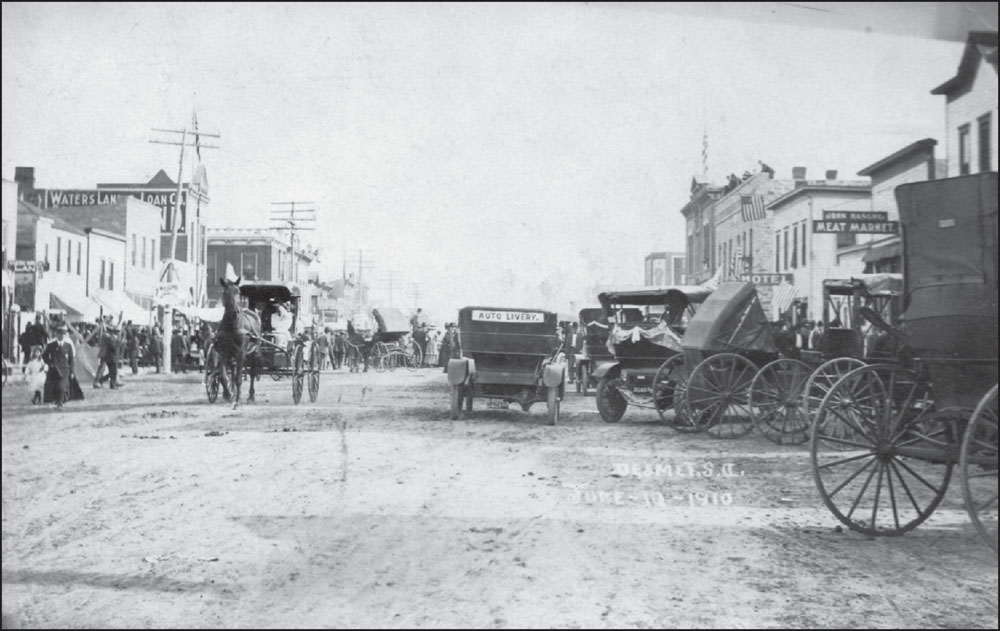
The growth and character of De Smet was influenced by the expanding West. A profusion of ethnic backgrounds built the “Little Town on the Prairie.” As business opportunities arose in the town, folks took advantage by engaging in many different occupations. Due to the vigor and spirit of early settlers, the small town prospered, with irresistible appeal.
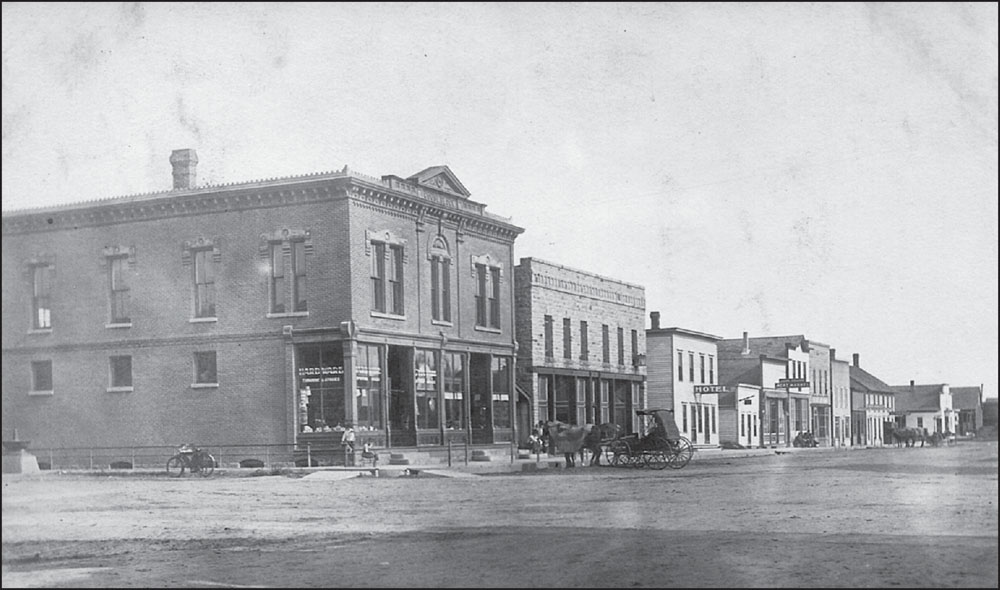
This imposing sentinel still stands at the corner of Calumet Avenue and Second Street. The Couse Building is located on a busy corner. Built in 1866, it was home to Miller Hardware, Bouchard and Son, J.C. Penney, and Ward’s V Store. The grand structure housed the opera house on the second floor, and during the ensuing years it would be used for plays, graduations, basketball games, and other functions.
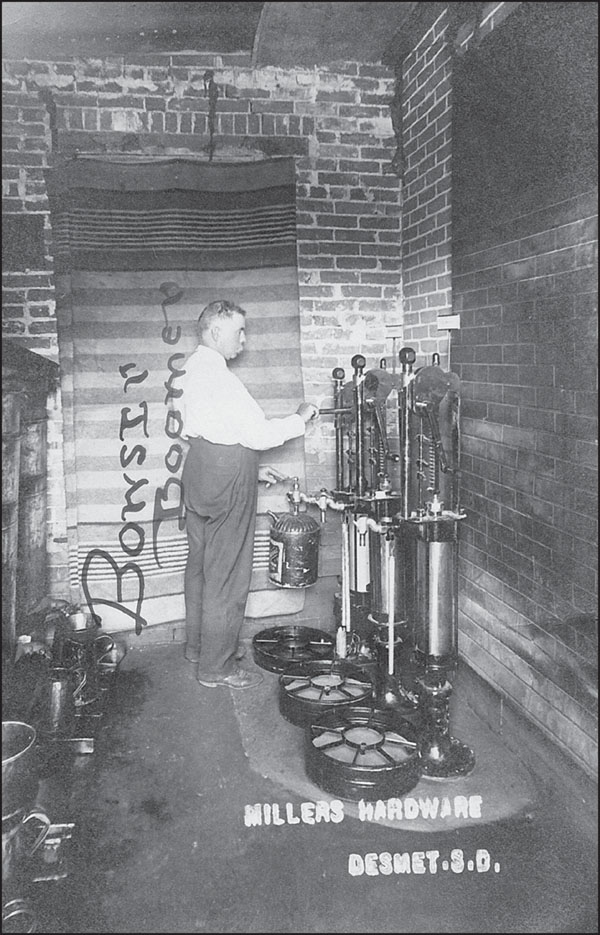
The shadow of De Smet’s past lingers in this photograph of Miller’s Hardware, on the northwest corner of Calumet Avenue and Second Street. Many opportunities arose in town, and Ig Miller took one to offer kerosene in his hardware store. The bricks are laid neatly on the right-hand wall, but an apprentice mason may have laid the back wall.
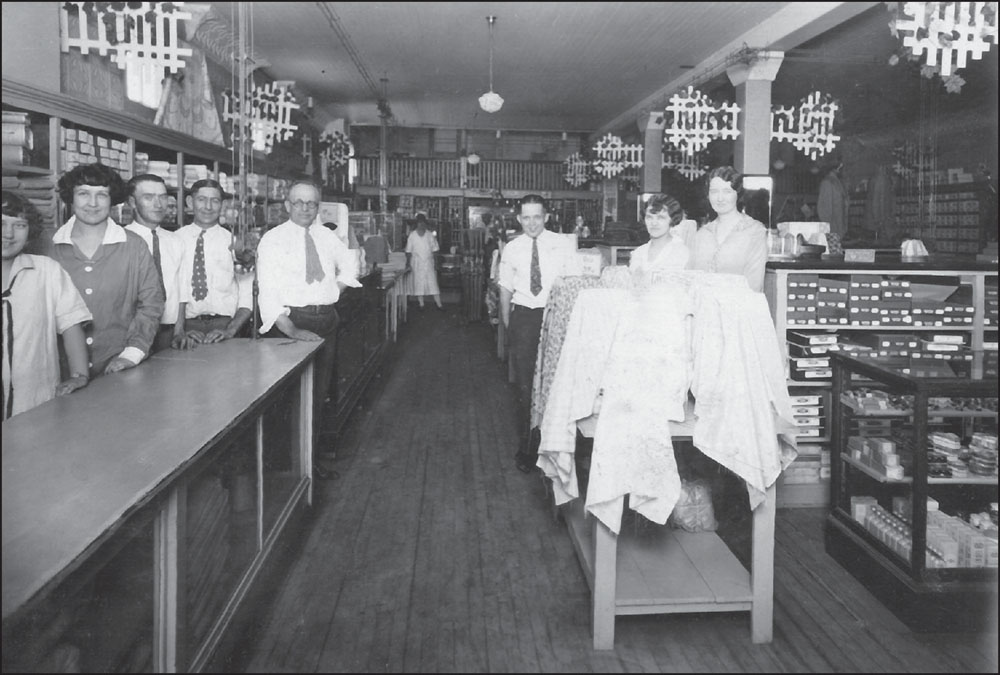
The Couse Building is seen here in 1923; Bouchard’s employees in this picture are, from left to right, Lydia Evans, Viola Evans, Curtis Schultz, Clyde Riley (manager of the grocery department), E.J. Bouchard (owner-manager), Josie Block, Edgar Bouchard (bookkeeper), Florence Evans, and Edith Erckland. Attached to the counter is the “money cup,” where the money was inserted, the chain was pulled, and the cup made its way to the bookkeeping department on the upper level behind the railing. Change was then made and returned.
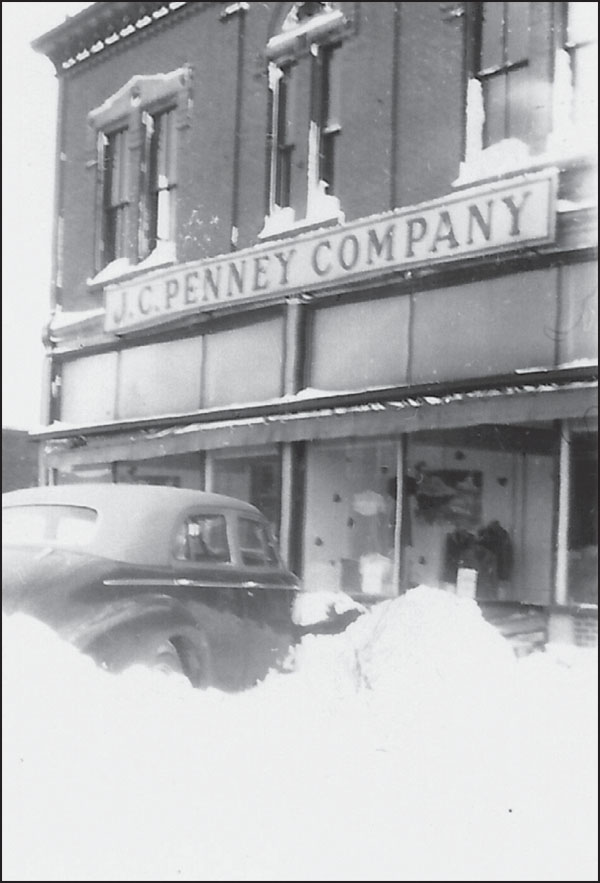
J.C. Penney arrived in De Smet in 1929. Placing its merchandise on the shelves of the former Bouchard Department Store, it was an immediate hit in the small town. Employees on this frigid, snow-piled day of 1943–1944 included Don English (manager), Al Kayser, Henrietta Hendricks, Marion Nienstadt, Beulah Lindsay, Vera Grotta, Elaine Coughlin, Rachael Moe, Pat English, Betty Bergstrom, and Elfriede Keiser.
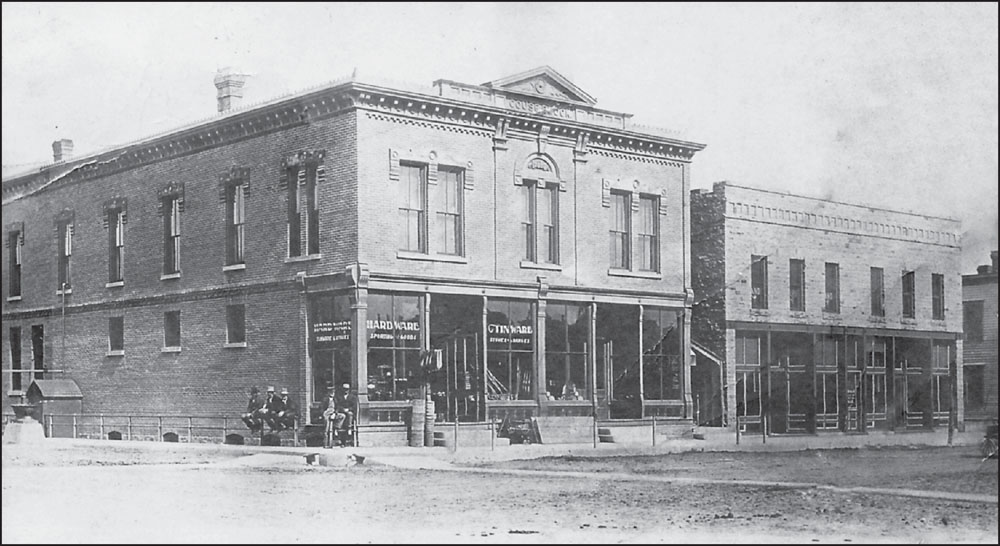
Take note of the second building on the right. Fred Floto, proprietor of this pool hall and tavern, offered an obvious place of enjoyment. It was built by a Mr. Healy in 1904 and sold to Floto.
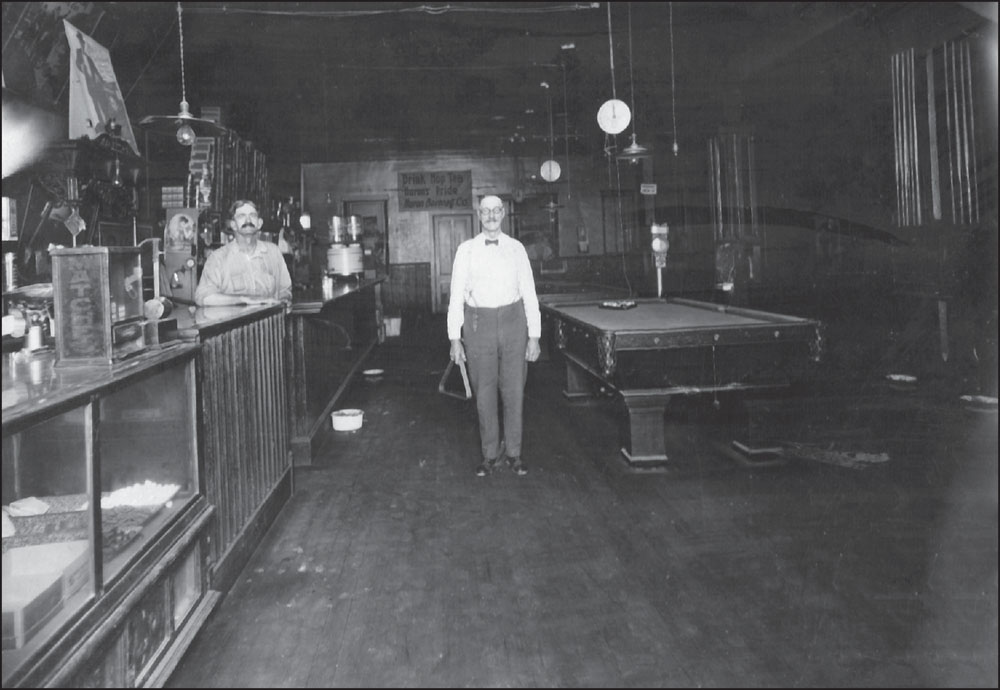
Klinkel’s Taven is a business many citizens will be familiar with. William Klinkel Sr. (right) and George Klinkel purchased the tavern from Fred Floto (left) in February 1921. Klinkel’s continued with the time-honored tradition of pool and libations.
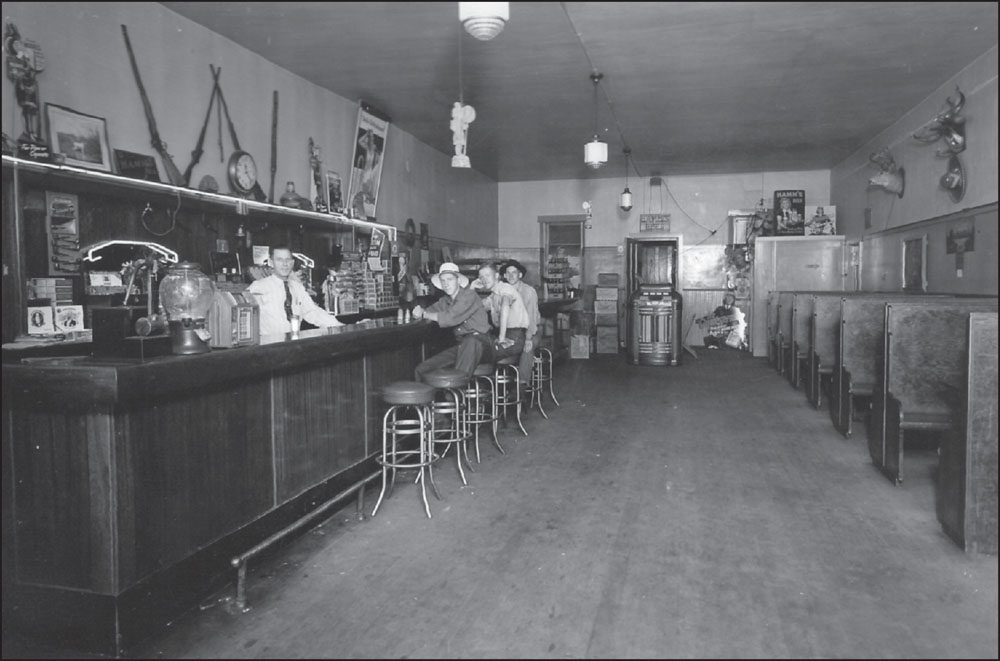
Pearl (Klinkel) Stubbe wrote the following information about this picture: “Klinkel’s Tavern, August 14, 1942. George Klinkel behind the bar; on the stools: Walt Klinkel (front), Bob Klinkel and Richard Smith.”
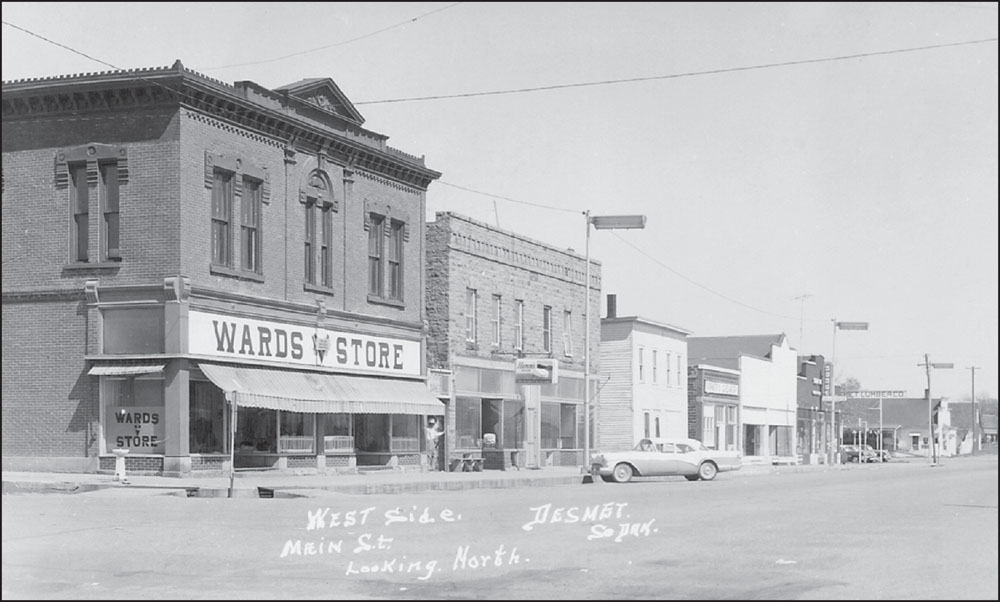
Walt and Alice Klinkel continued the Klinkel tradition by purchasing the tavern and pool hall business (second building on the right) in 1951 from Walt’s sister, Pearl, and her husband, Bill Winsor. From 1958 to 1962, George Erger operated the business. Walt and Alice again entered the picture in 1962. Still standing on Calumet Avenue, the building has been owned and operated as the No Name Inn and the Dugout.
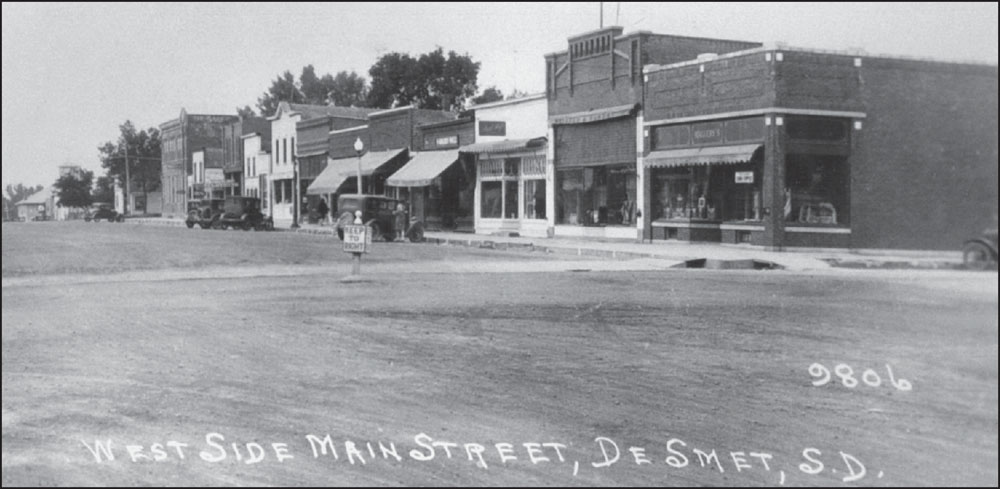
The third building from the right housed the store of Loftus and Broadbent, one of the oldest business establishments in De Smet. In 1930, Daniel Loftus was said to have one of the longest records as a local merchant.
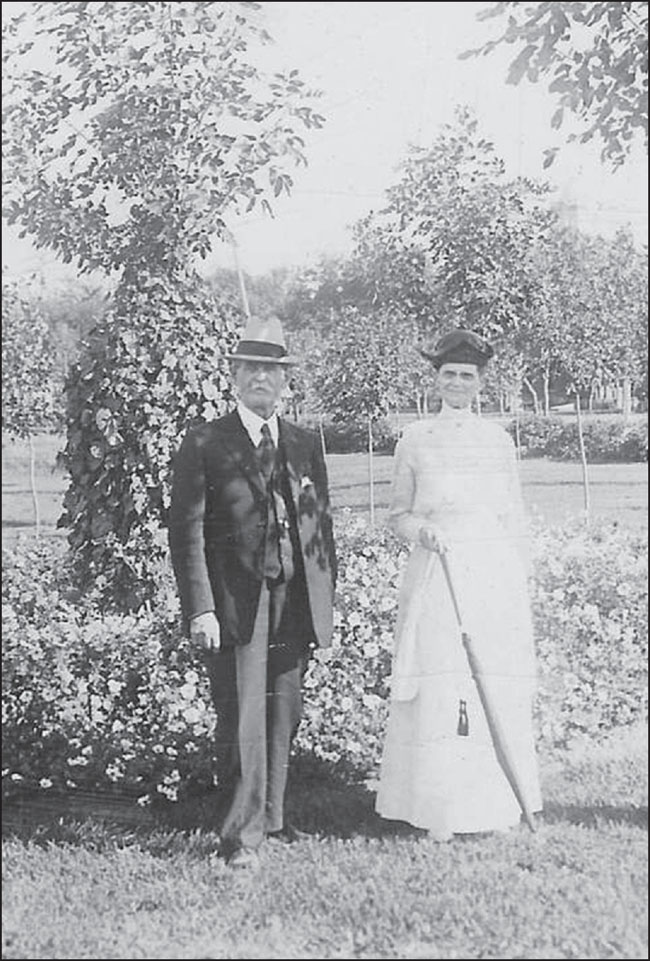
Posed in front of Railroad Park’s floral circle, Daniel and Helen Kate Loftus have a colorful background for this sophisticated picture in the early 1900s. This gentleman was Loftus of Loftus and Broadbent.
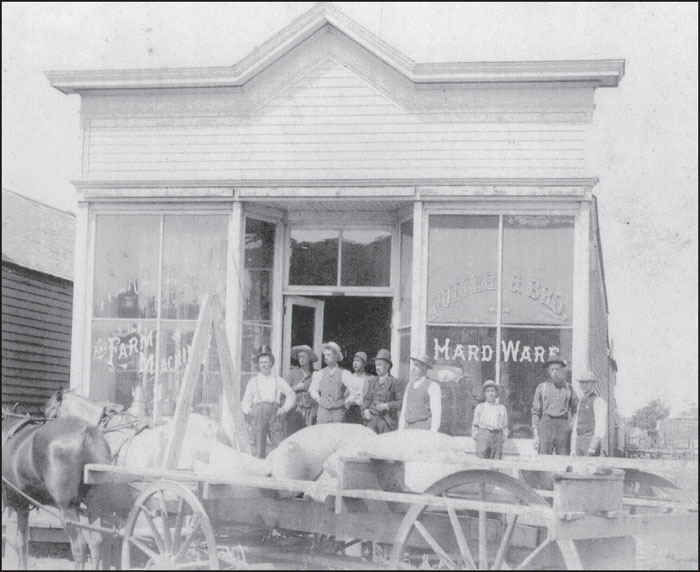
Countless families bought their supplies in the little town at the Fuller Hardware. Families lived on the land, and this wagon stacked with sacks of feed or seed is evidence of the De Smet area being farmland. The cloth sacks could have been a joyful sight to the women, as they were used for clothing and other items made from the material once the sacks were emptied.
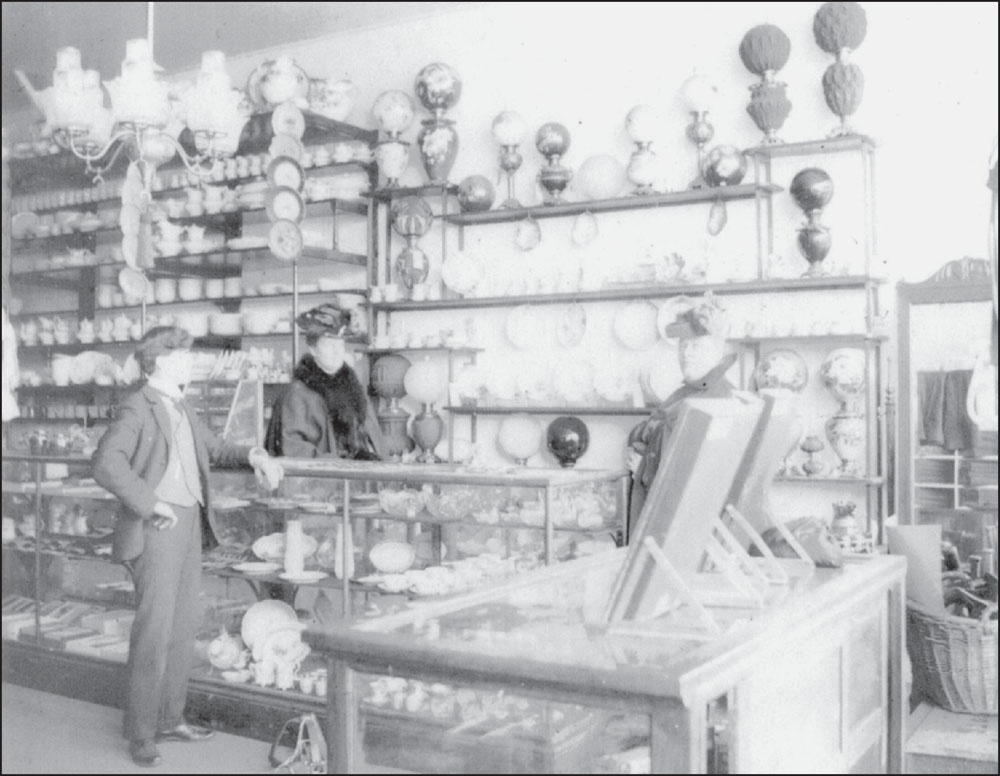
The clerk, ? Reddy, is available to help Chloe Dow Fuller (left) and Bersha Dow Dunn (right) in the Fuller Hardware Store, located at the corner of Second Street and Calumet Avenue. It has the distinction of being De Smet’s first hardware store. Through the years, this was the location of Burkhart Bros., Tennies, and Buchele Drug.
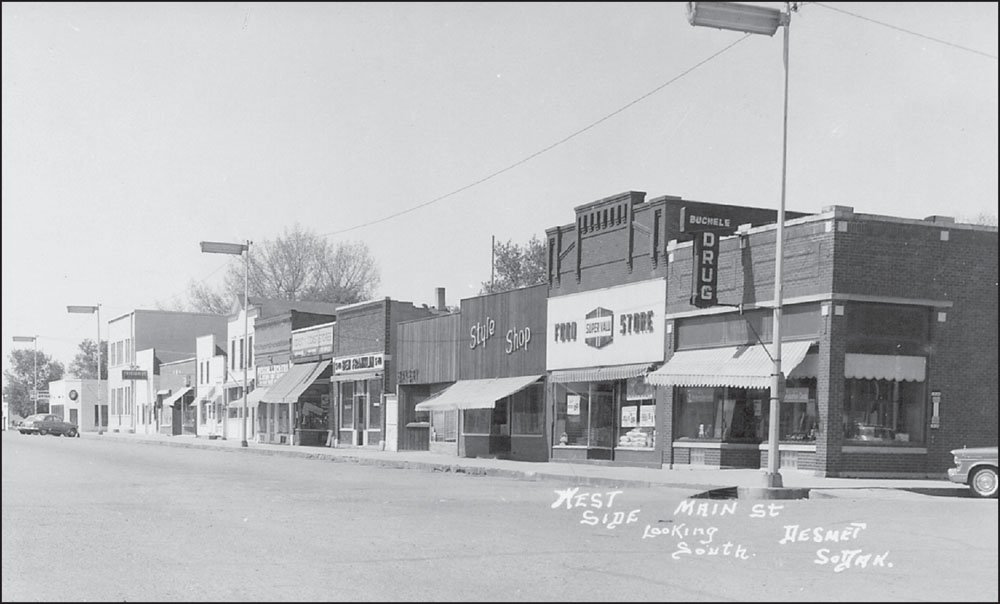
Two different worlds are seen on this page. The Super Valu Food Store (once Mallery and White Drug) appears to have changed very little structurally. Seen in this c. 1950 image are Buchele Drug, Super Valu, Style Shop, City Bakery, Ben Franklin, Coast to Coast, Peschl Locker, B.J. Hasche Insurance, a barbershop, Wika-Jensen Insurance, Floyd’s Jewelry, Ryland’s Men’s Wear, Dakota Shoe Shop, Huisenga Appliance, and Dr. Scofield’s dental office.
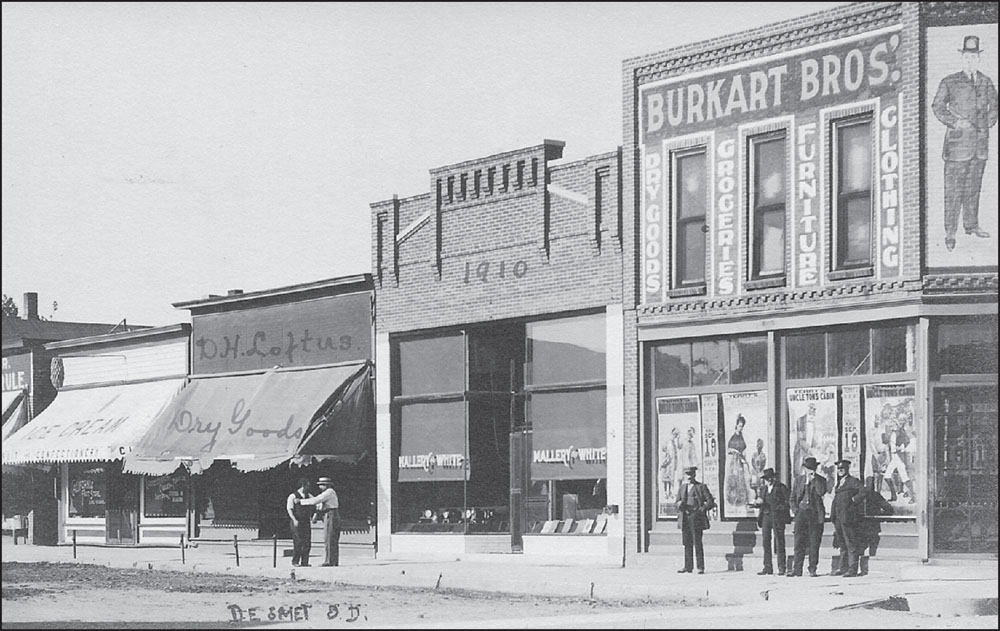
Merchants found a thriving livelihood in the new town. This postcard from 1910 shows the business places of Burkart Bros., Mallery and White Pharmacy, D.H. Loftus Dry Goods, Ice Cream and Confectionaries, and the Golden Rule. Notice the pineapple hanging over the awning of the ice cream store.
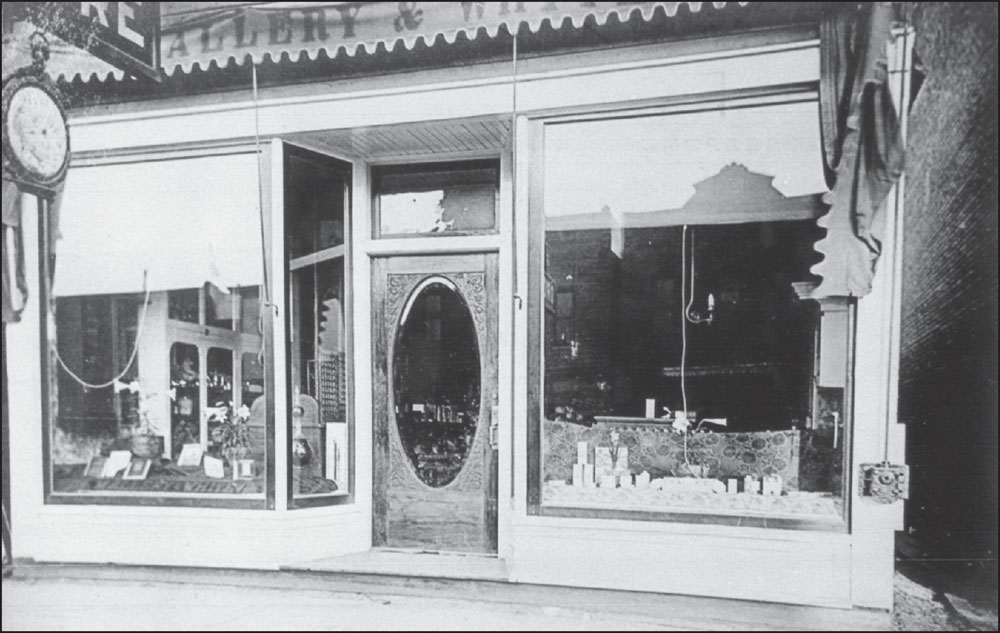
Recessed doorways helped deflect the cold of winter when they were opened, and Mallery and White Drug Store had a beautiful door with oval glass. Note the awning evidently installed after the 1910 postcard previously viewed. The mechanism to raise and lower the awning is at the right-hand side of the window. The hanging clock (left) is actually on a sign near the curb.
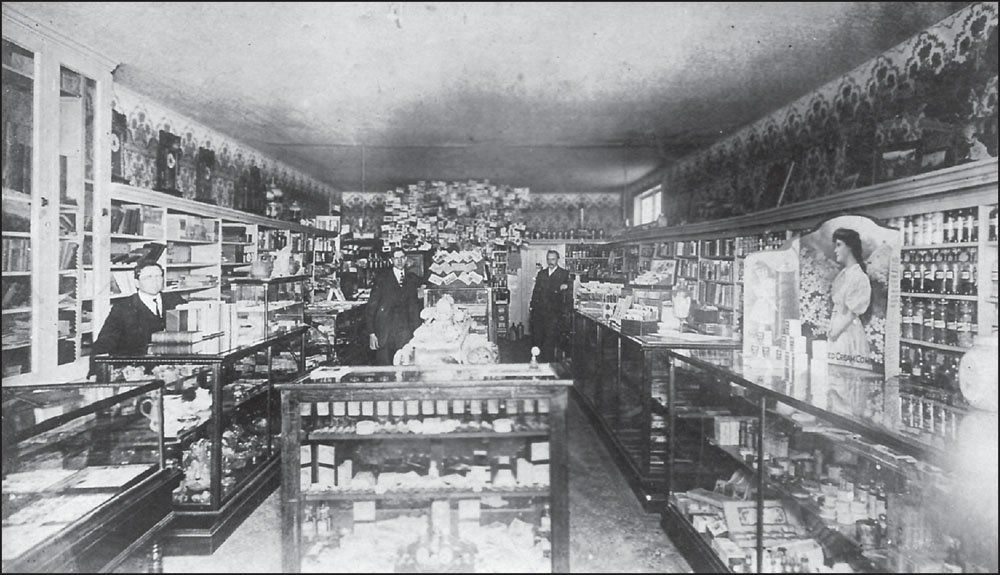
This is not just a simple pharmacy, but actually a magical place where every inch was put to good use. Around 1910, Mallery and White was located in the building most recall as the Super Valu Store, located on the west side of Calumet Avenue.
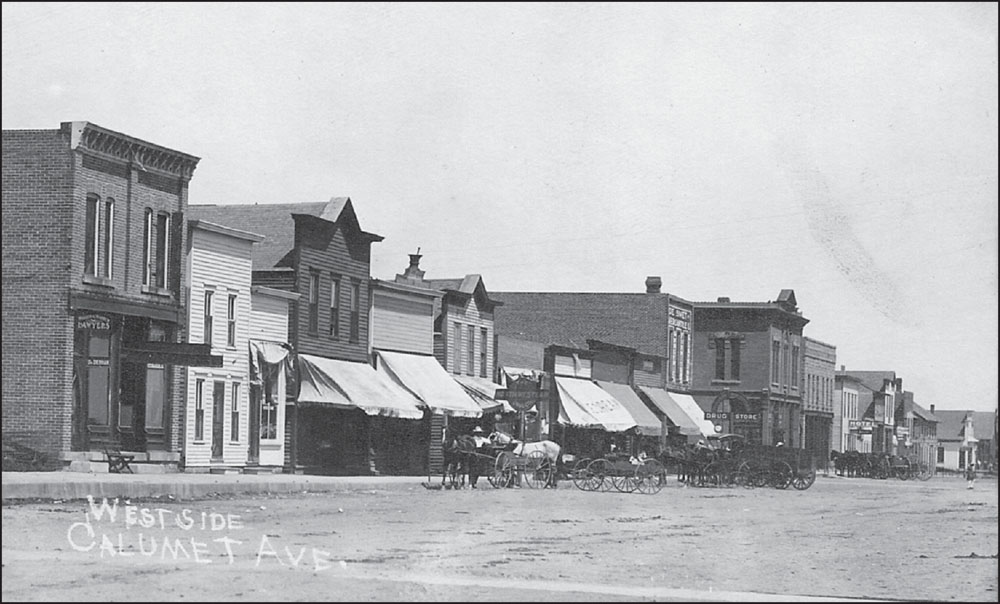
Note the businesses lining the second and third blocks on the west side of Calumet Avenue; included in this scene are law offices, the North Western Railroad office, Tinkham Furniture, Golden Rule, a confectionary, Loftus, Mallery and White, De Smet Mercantile, Miller Hardware, Floto Tavern, Spurgeon Hotel, and Meade Hotel.
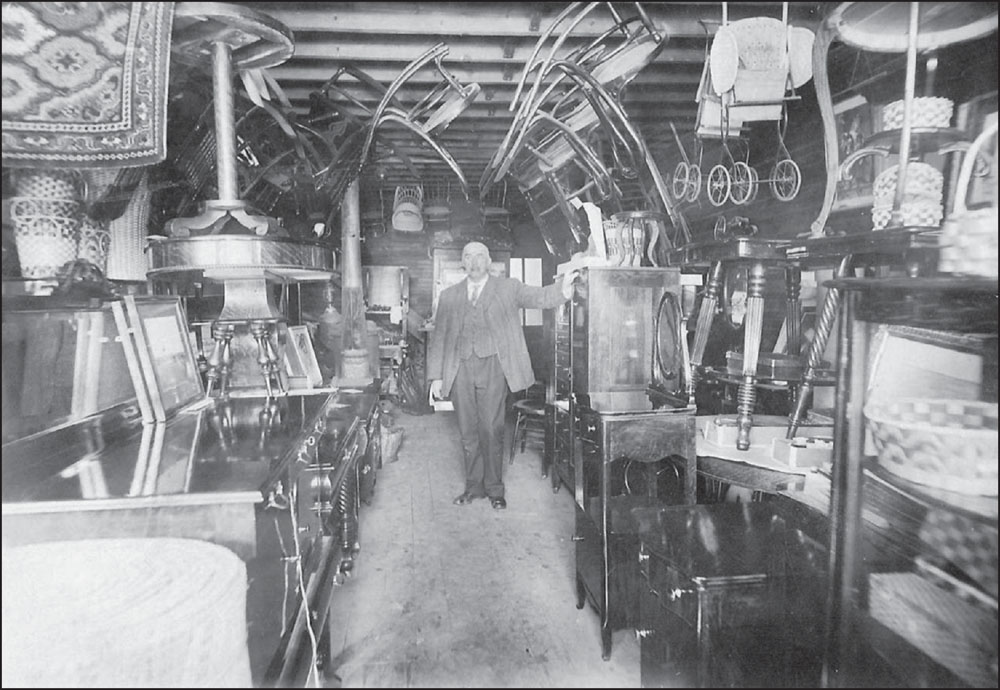
De Smet grew quickly, and C.H. (Charles) Tinkham was willing and ready to meet the demands for furniture. He stands in the aisle of his store, where it would appear as many items hang from the ceiling as sit on the floor.
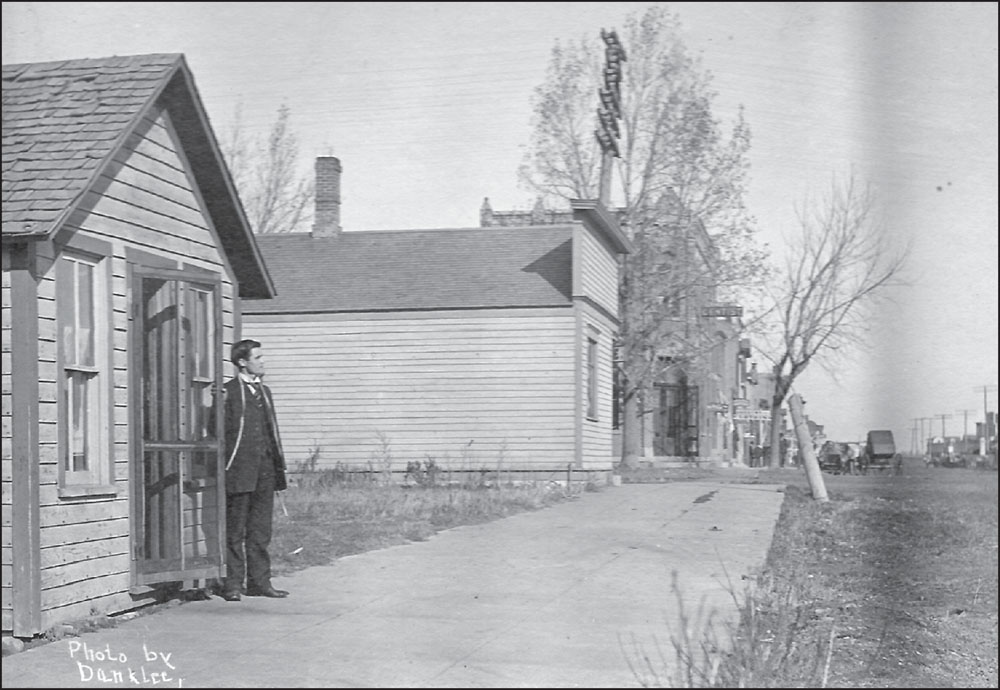
The era of the gentleman’s tailor is today long gone in De Smet, but tailor Nelson stands here waiting for business. His trade is depicted by the tape measure hanging around his neck. Earlier, this was the home of Cooledge Photography. When the Jaycees razed the structure, they found tintypes from the shop. Located on the south end of Calumet Avenue on the west side, it was also the home of Alvin and Alice Klinkel for several years.
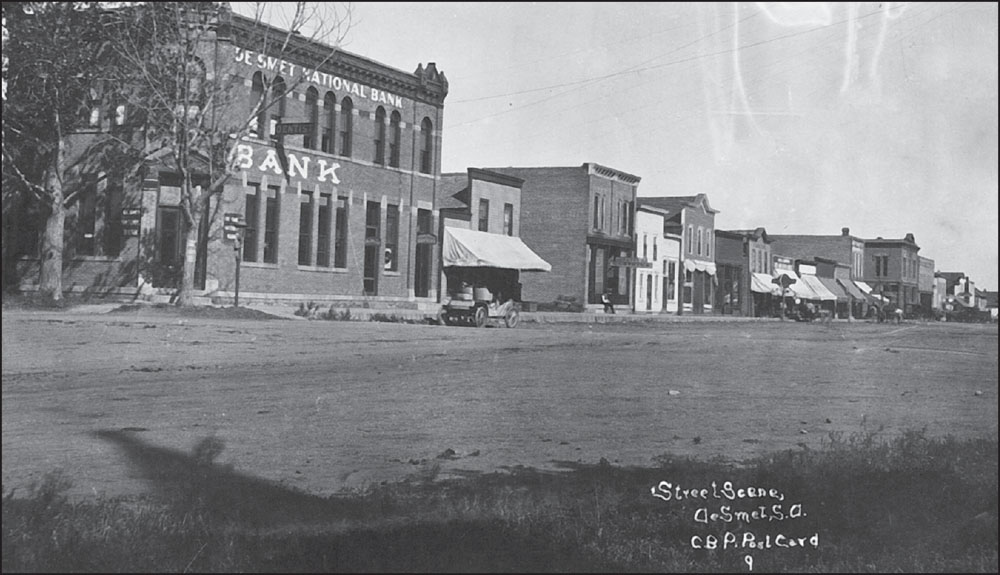
In the early 1900s, the De Smet National Bank (formerly Kingsbury County Bank) was located at the corner of Calumet Avenue and Third Street. The gaslight, standing on the corner, was lit in the evening hours.
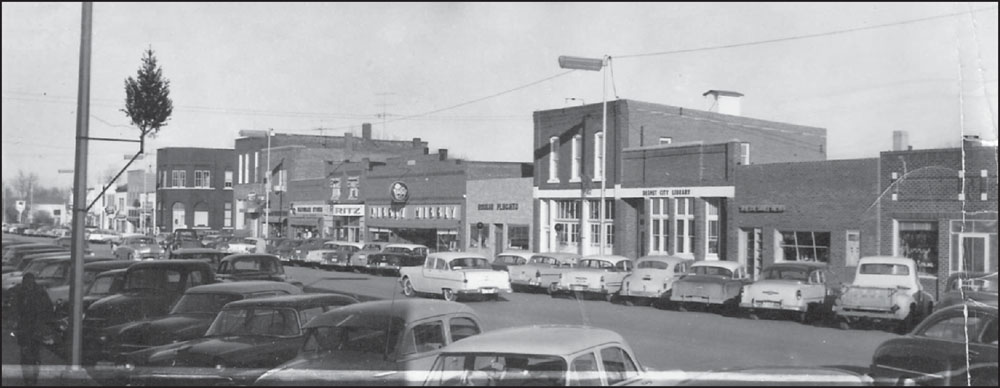
Piggly Wiggly was one of the first supermarket chains in the country. De Smet had its own, as shown in this picture of Calumet Avenue’s east side. The De Smet Piggly Wiggly was short-lived, but there is no doubt from this picture that De Smet was a shopping hub. A Christmas tree on the lamppost may indicate a Christmas without snow that year.
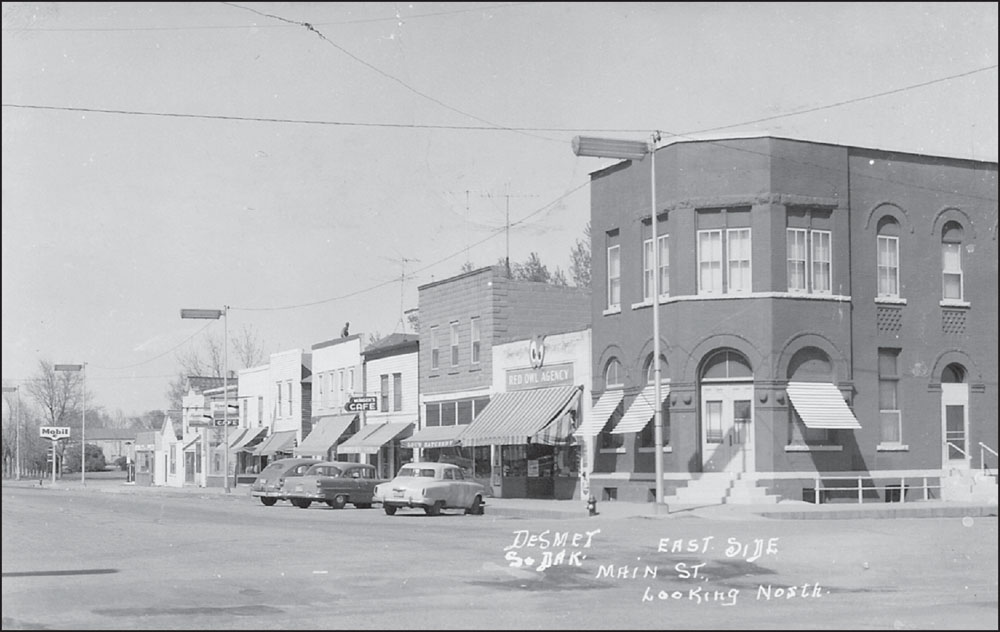
The “Friendly Red Owl” and Brick Coughlin invited people to shop at the Red Owl Agency on the east side of Calumet Avenue. De Smet folks could pick up their hatchery needs at Lou’s Hatchery and have a cup of coffee with a piece of homemade pie at Howard Munger’s Café.
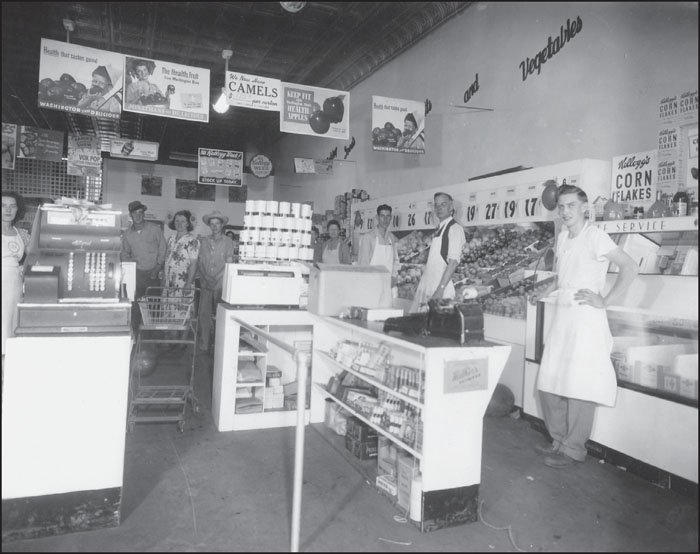
This c. 1940 photograph depicts the inside of the prosperous Super Valu store, owned by Henry Hinz. A shopper could lift the wire basket from the top of the cart and carry his or her groceries to the car. Don Wilkins is in the foreground. The other folks are unidentified.
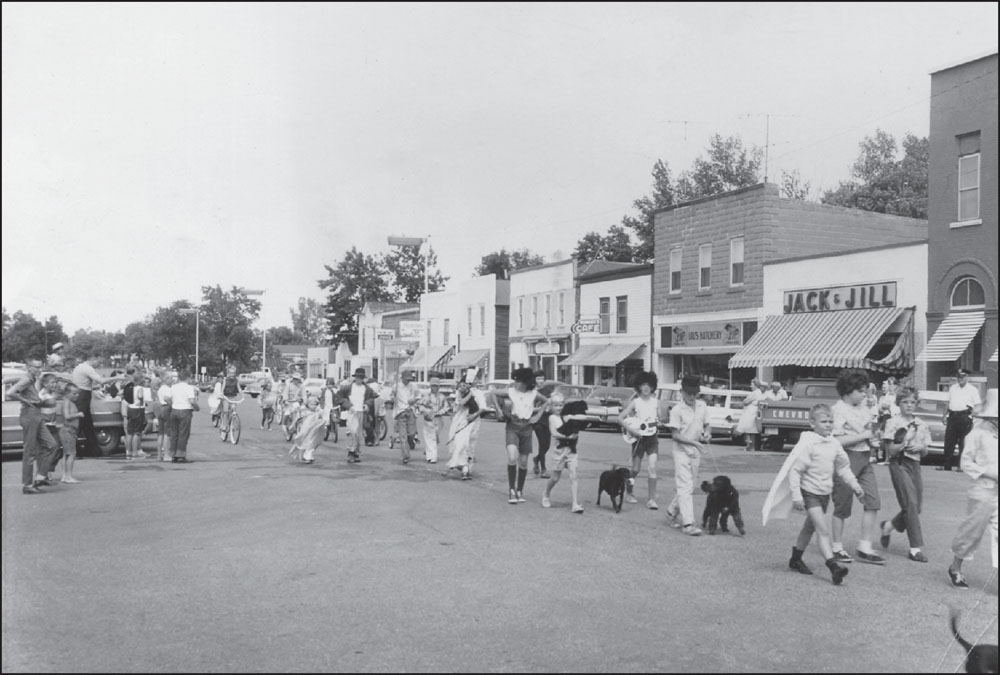
The Jack & Jill store sign has changed, but the building remains on the east side of Calumet Avenue. Along the street, from right to left, are Lou Wolkenhauer’s Hatchery, Munger’s Café, Connor’s Café, a barbershop, Sy’s Tavern, a bowling alley, a Laundromat, a dry cleaner, and Schoonover Sports. On the right, chief of police Laurel “Bill” Ritenhaur watches over a parade of children, pets, and bicycles. Gary (left), Connie (center), and Cathy Penney are at the front of the picture.
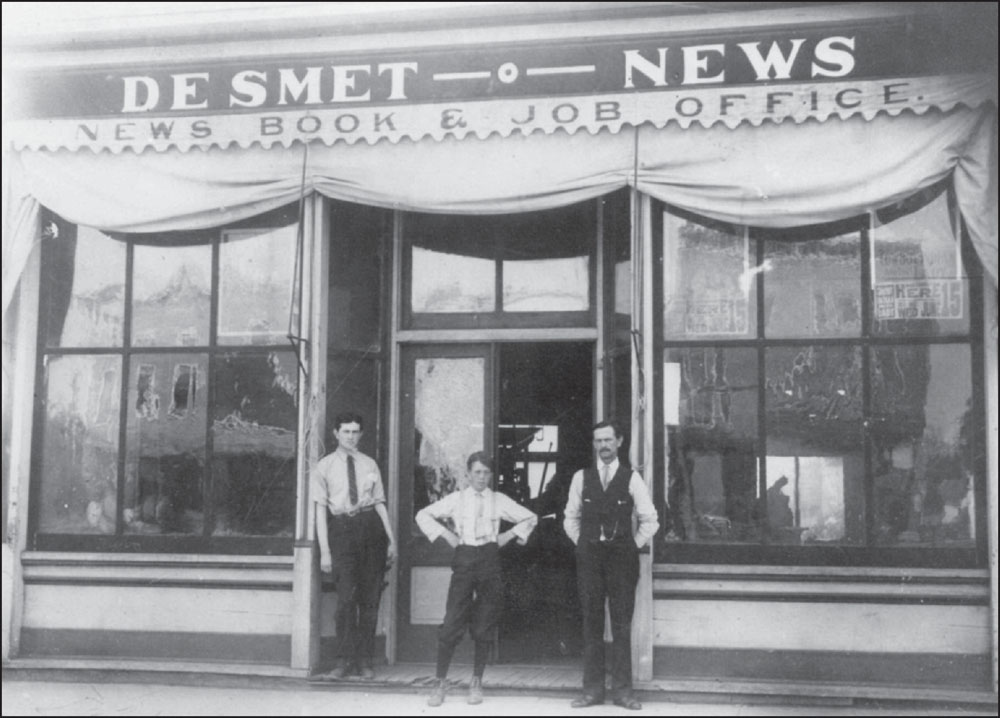
Kingsbury County’s first newspaper, the Kingsbury County News, arrived here in 1880. The first owners were Jake Hopp and George A. Matthews. Other gentlemen and other newspapers evolved in De Smet, but at the turn of the century, Carter Sherwood formed the De Smet News. After 134 years, the paper operates under the auspices of Dale Blegen.
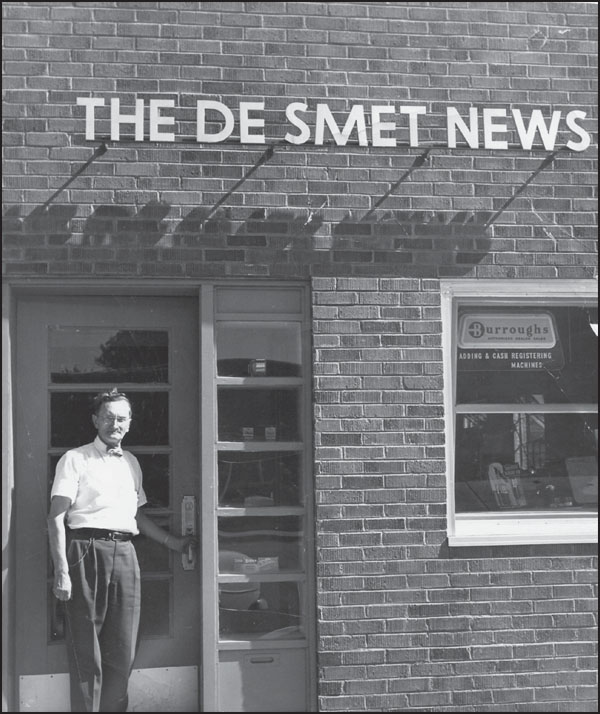
Many people touch lives, but Aubrey Sherwood touched the heart of De Smet with his newspaper and his friendships with author Laura Ingalls Wilder and painter and illustrator Harvey Dunn. He is seen here entering his place of business in the 1970s.
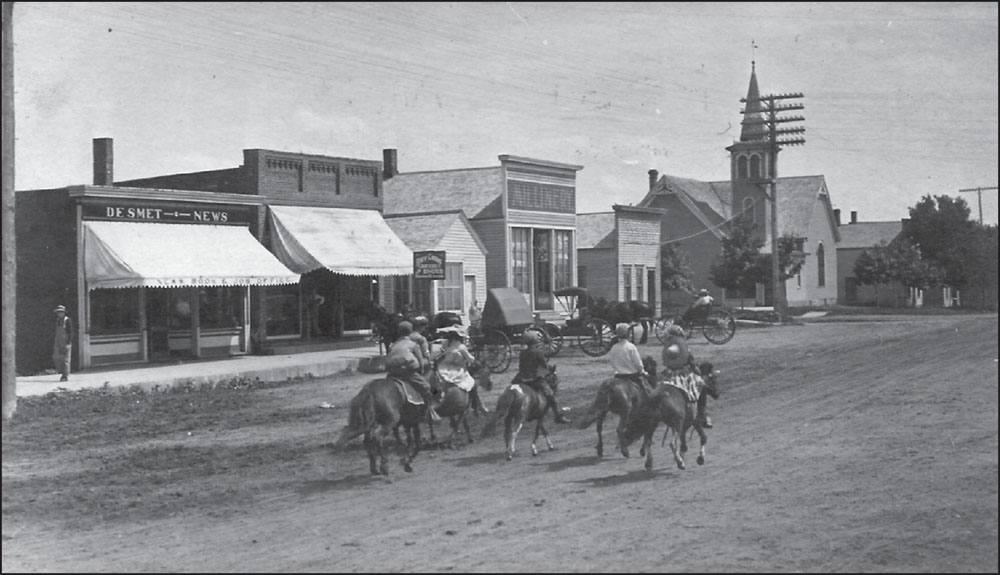
In this postcard, ponies are ridden down the middle of Calumet Avenue with the De Smet News office, the shoe store, a millinery establishment, telephone office, and the Evangelical church along the route.
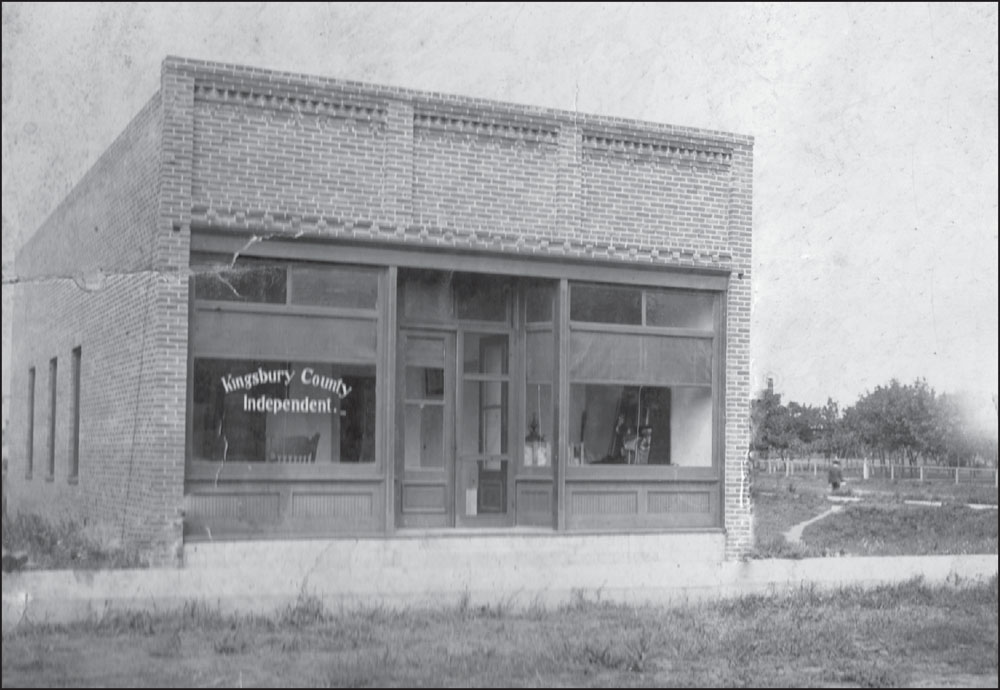
The office of the Kingsbury County Independent appears to stand pretty much by itself on the north side of Second Street. The Kingsbury County Independent was started by George Lattin in 1894. He sold out to Fred W. Wright (later a De Smet News employee) some years later, and Fred published the paper for 30 years. In later years, this building housed the Municipal Liquor store. On the right, an unidentified person can be seen walking toward the courthouse.
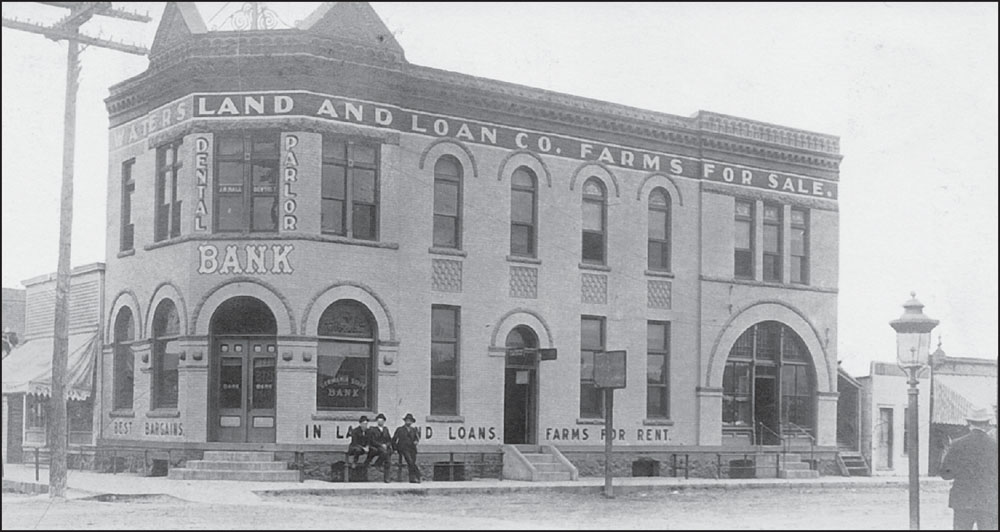
The much admired Waters Land and Loan Building anchors the northeast corner of Calumet and Second Street. Germania State Bank occupied a portion of the building, and customers could do business there by entering the double doors on the rounded front. A utility pole in front of Waters building and a gas streetlamp standing across the street indicate the changing times. An abstractor was also located in the building.
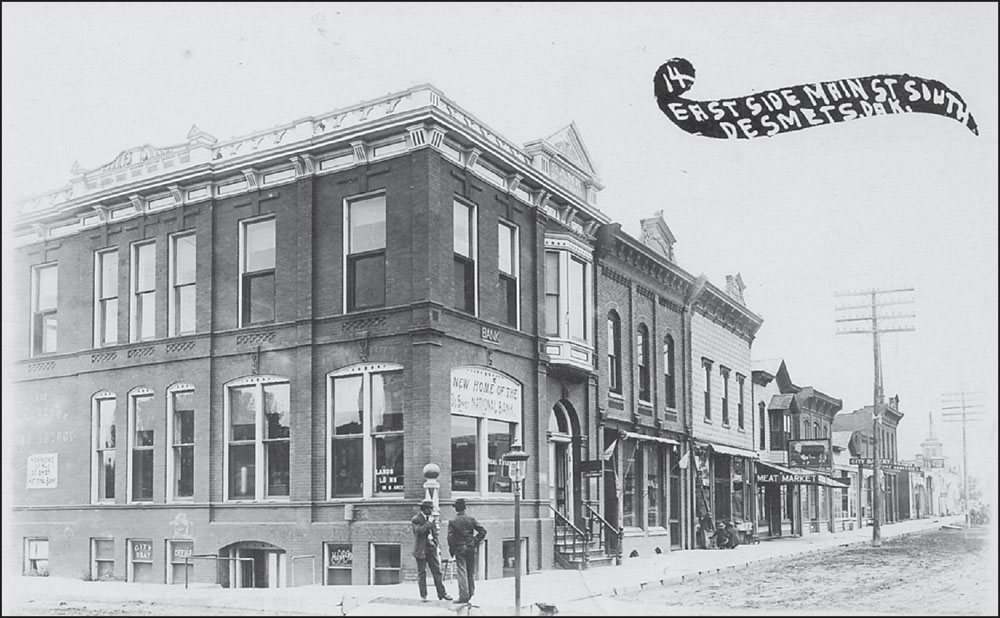
Anchoring the southeast corner of Calumet Avenue and Second Street is the “New Home of the De Smet National Bank.” Over the years, it has lost some of its facade, but for all practical purposes, it looks the same today as it did over 100 years ago. The barber pole advertises the barbershop in the basement. The basement windows indicate that the City Dray office is located there also. For many years, it has been a law office for attorneys Green & Green and Gregg Gass.
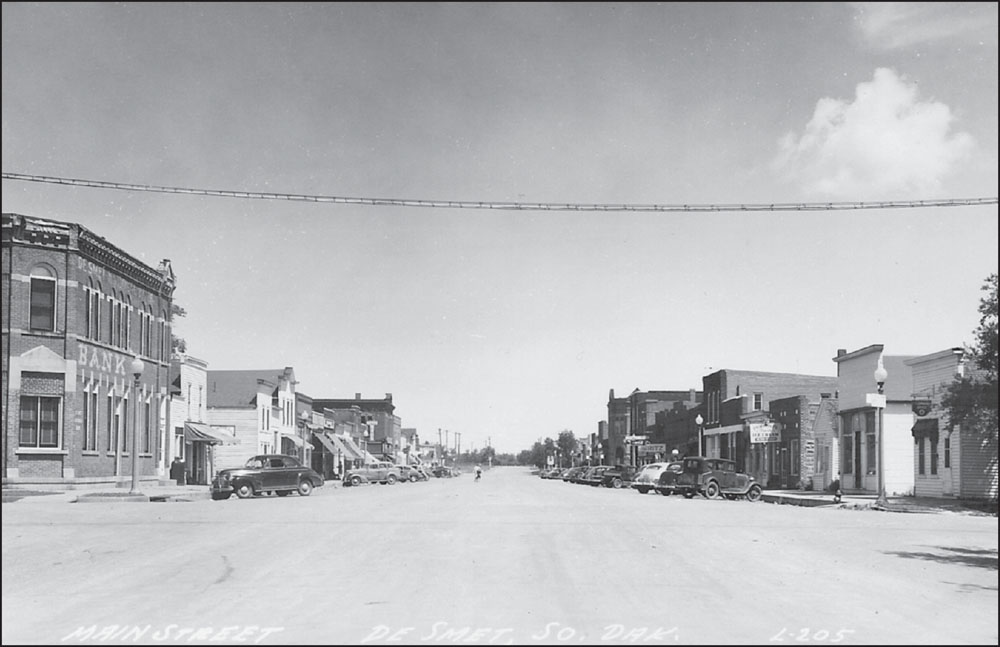
The original site of the De Smet National Bank was at the southwest corner of Calumet and Third Street. Noteworthy is the telephone office setting directly across the street on the east corner. Gas streetlamps have disappeared and electric streetlights and readily available fire hydrants reflect the prosperity of the growing town.
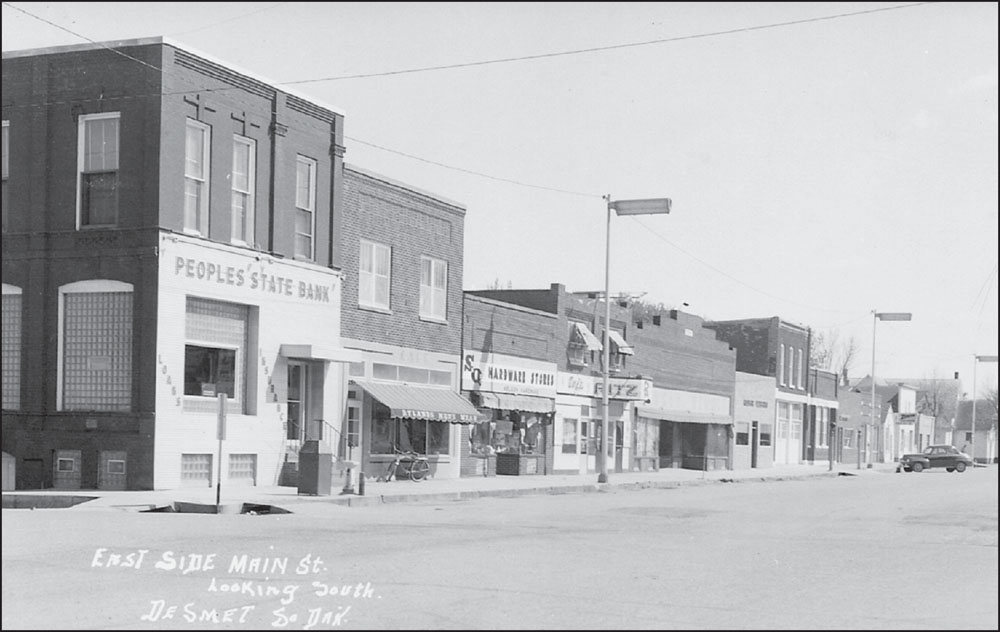
Peoples State Bank was on the move again. It withdrew from the former Waters Building and settled in the former National Bank building. As can be seen in this image, the metal-covered trash can helped with waste management. A water fountain was available for the public.
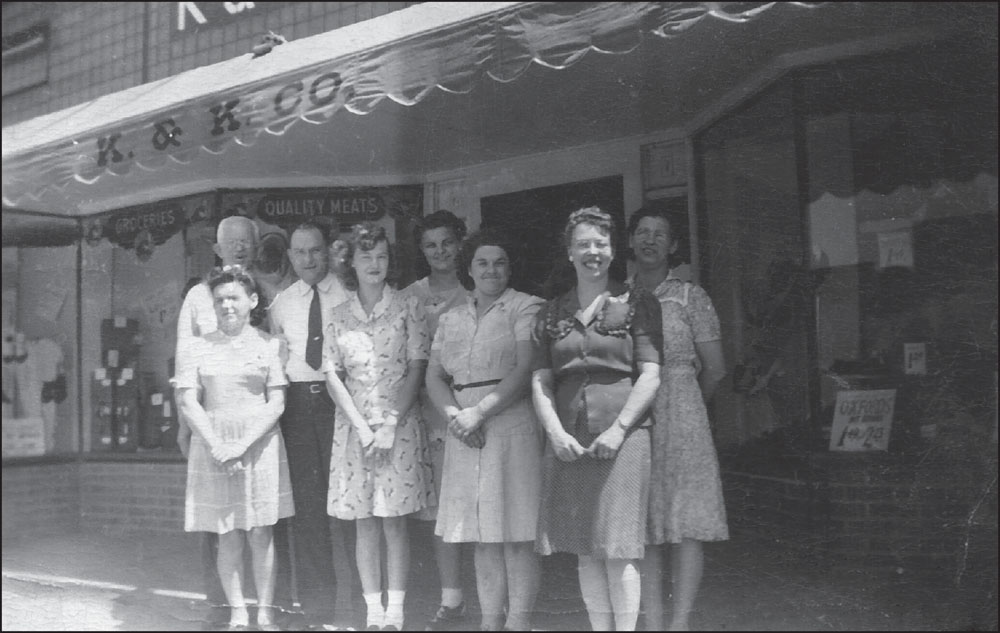
One-stop, no-frills shopping at K&K Store (Kutcher and Kutcher) was the idea the staff promoted. Standing in front of the store are, from left to right, (first row) Katie (Jacobs) Siver, Milt Fishgold, Florence “Sis” Burns, Katie (Renner) Jacobs, and Leona Brandt; (second row) Jack Luebs, Howard Schultz (hidden), Sina Woodbury, and Lottie McGarvie. This location on the east side of Calumet Avenue is now occupied by American Bank and Trust.
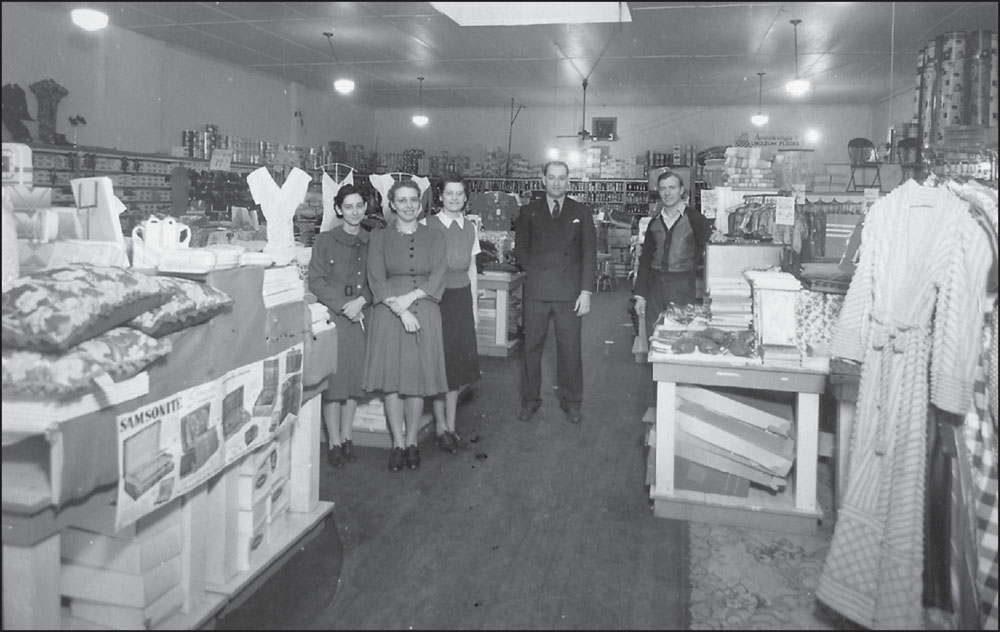
The grocery store was the center of everyday life, and a walk down the aisle of the grocery department in the K&K Store in 1940s could mean meeting, from left to right, Madge Rodney, Leona Brandt, Beulah Lindsey, manager Milt Fishgold, and Howard Schultz.
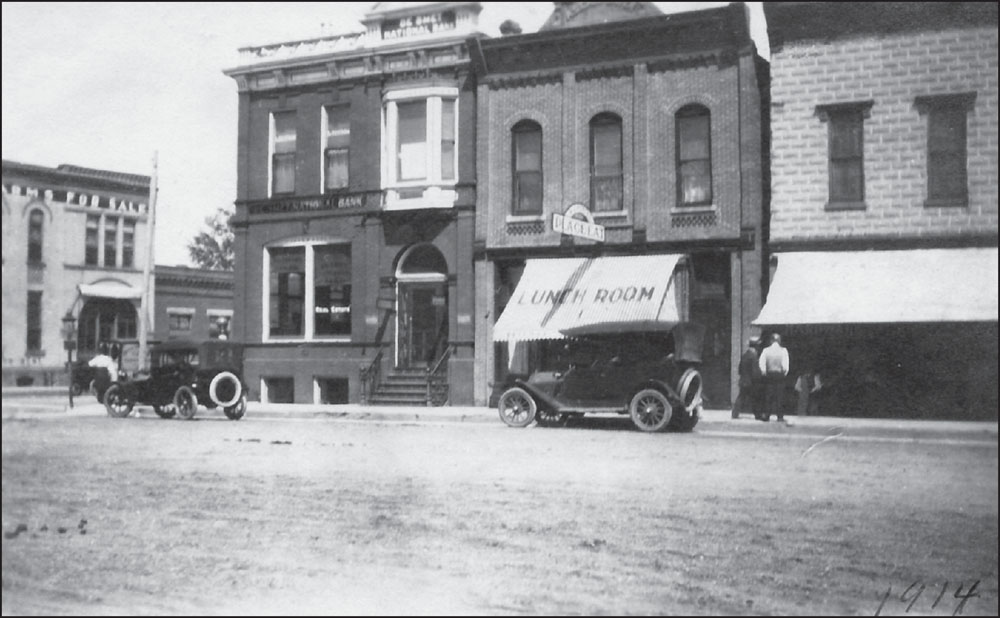
The Place to Eat Lunch Room was in a long-established building for many cafés, such as Burns Café and Gordon’s Café, to name two. Lace curtains in the upstairs windows indicate that these are living quarters for the owner of the Lunch Room.
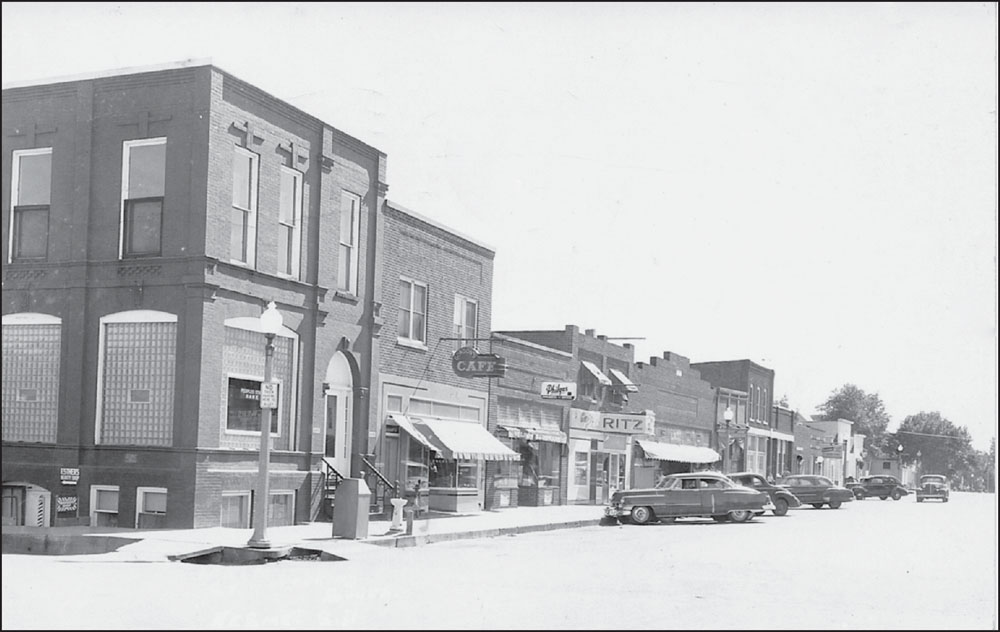
Notice the Gordon’s Café sign above the awning of the second building. A heaping plate of shoestrings and a bottle of Coke cost 35¢ in the 1950s.
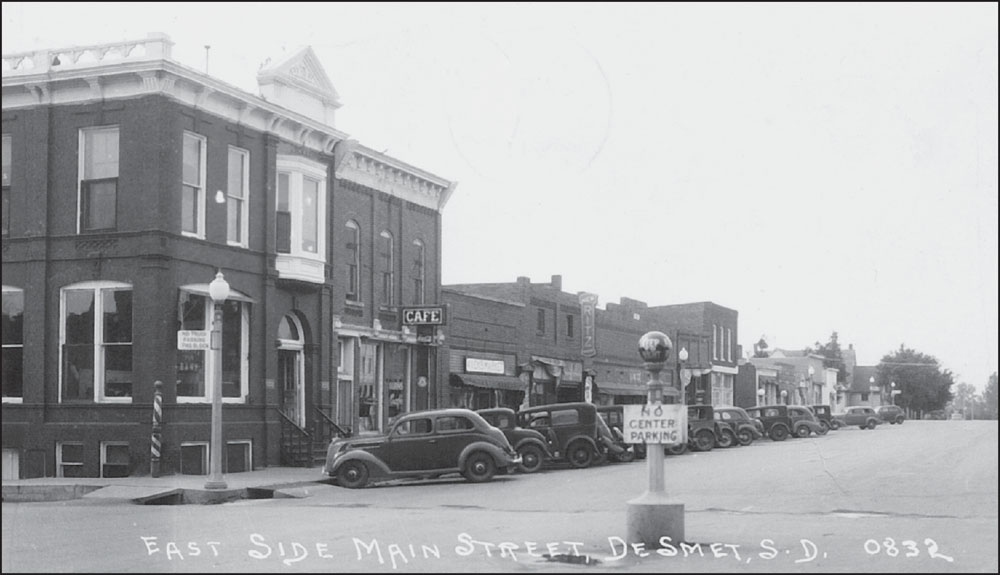
People definitely heeded the “No Center Parking” sign that stands in the intersection of Calumet Avenue and Second Street. Burns Café occupies the second building from the left in this picture, and Vick’s Market is to its right. All the cars parked at the curb are reminiscent of a Saturday night’s lineup.
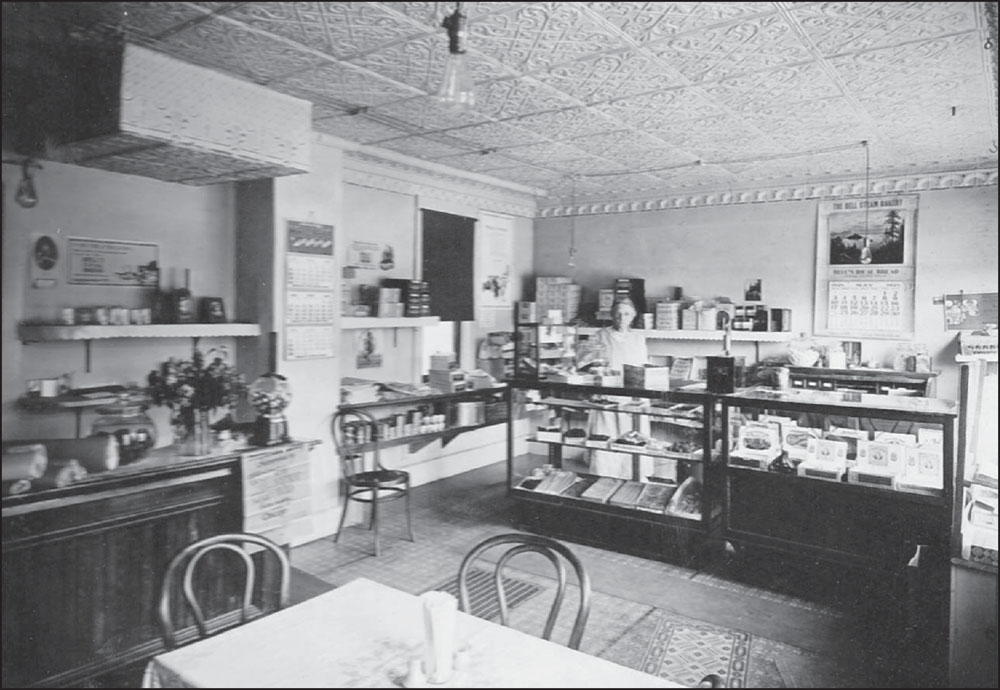
Carrie Ely stands behind her candy counter on a day in May. The round-bottom, bentwood chairs would seat customers having a meal or refreshments at her café in 1925. Future cafés in this location included those of Howard and Florence Munger (moving from the Ritz location to the south) and Lorane Washburn.
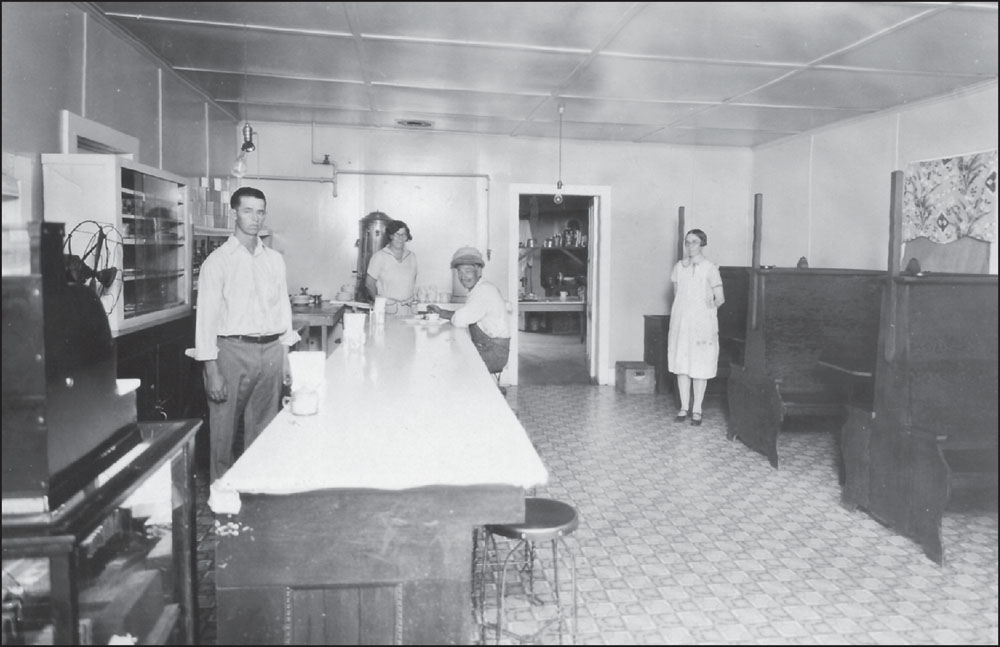
A Cavanaugh man is standing behind the counter of the Cavanaugh Café in this c. 1930 photograph. An unidentified lady stands at the end of the counter. Ed May occupies the counter stool, and Opal Liggett (later Mrs. Ed May) is shown by the booth.
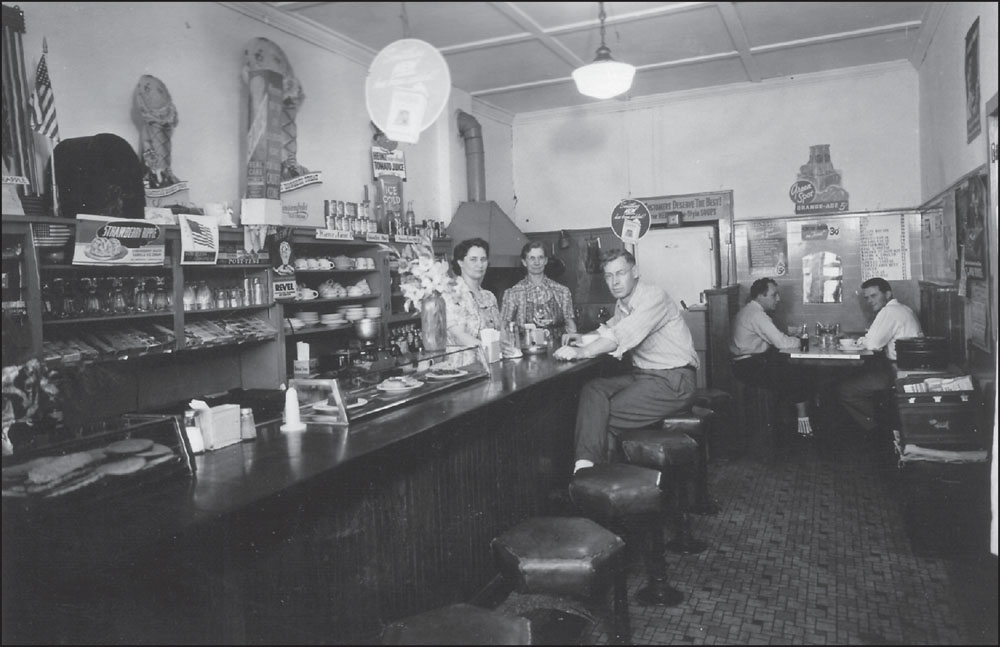
Once upon a time, Howard and Florence Munger operated the Ritz Café. In this 1942 image, Florence (left) stands behind the counter with Nora Luebs (right); Howard sits on the counter stool. An unidentified man is sitting in the booth with Harlan Seeley (far right), owner of the Ritz Theater just next door.
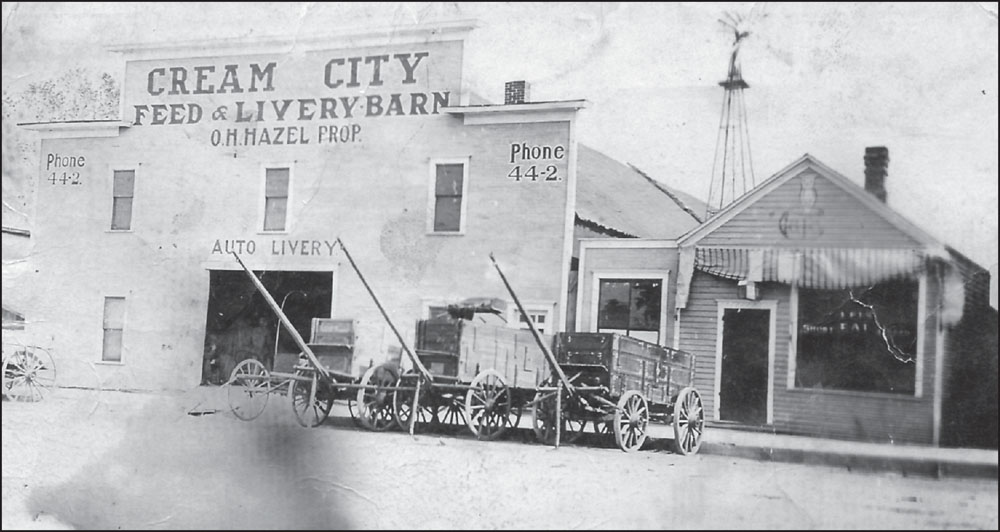
Early on, De Smet was widely known as “Cream City.” Here, O.H. Hazel proudly displays the fact on his Cream City Feed and Livery Barn.
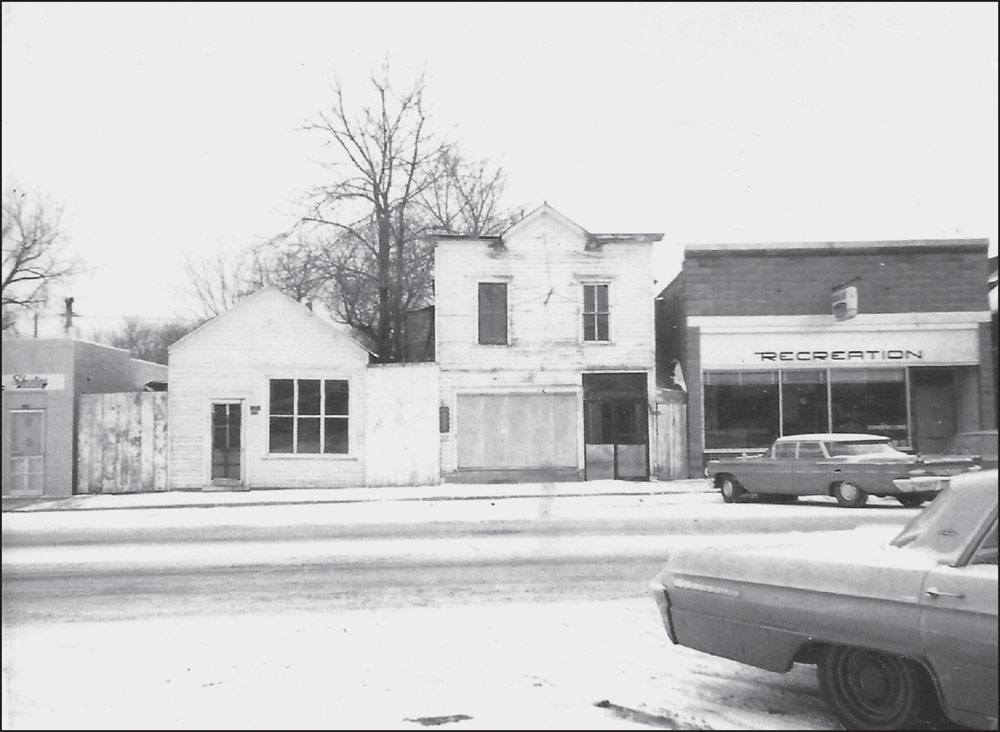
The small building with six windows and the tall building at center date back to at least 1883. Before they were razed, the small building was the De Smet Dry Cleaners, and then Dakota Arts and Countryview Catering. The tall building was Frank Schaub Harness and became NAPA, a Laundromat, and Wheaties. The “Recreation” building was owned and operated by various business owners—Cumming, Wehrkamp, Russ Schultz, Hilbert Schardinand, and Mervin Schultz. Many will remember it as a bowling alley.
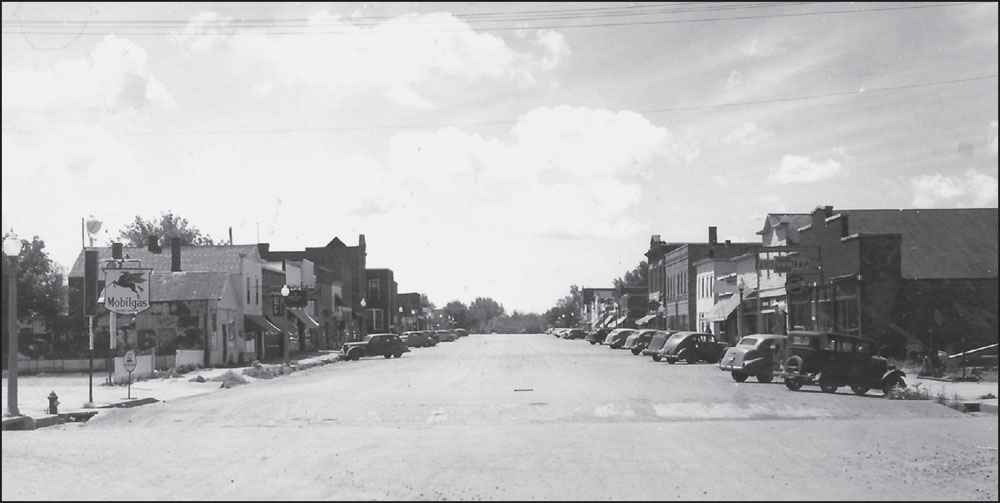
The sign showing the Pegasus entices customers to the Mobilgas station that stood on the corner of Calumet Avenue and First Street. A couple of former Mobilgas men that come to mind are Glen Van Tassel and Roy Brusse.
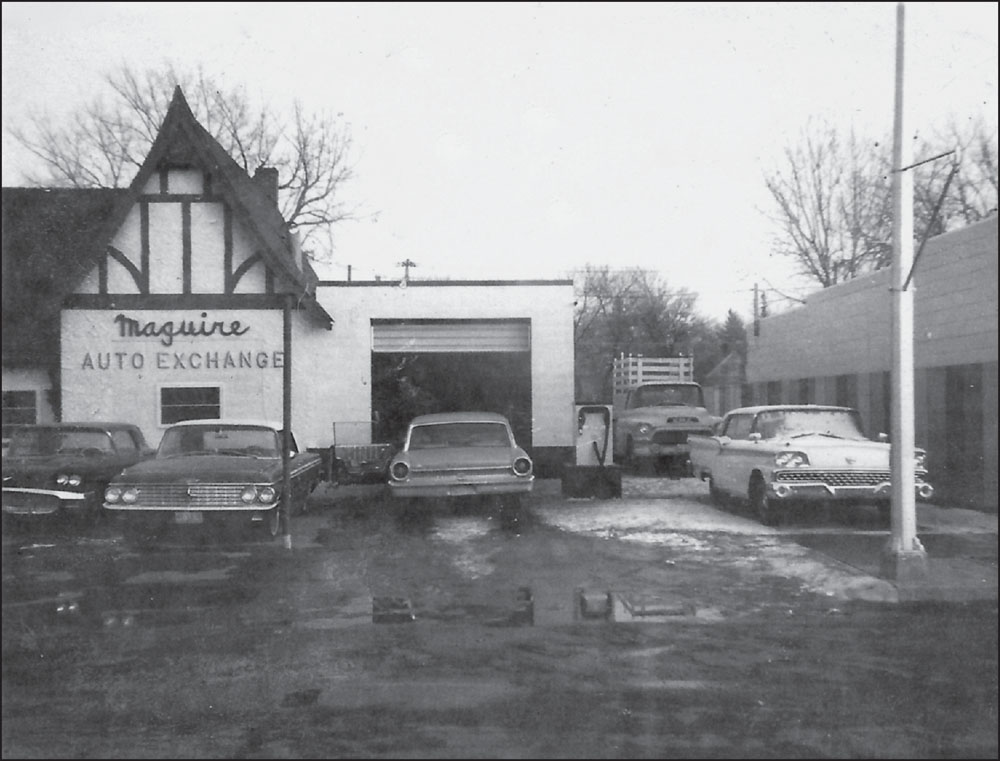
This quaint little building, which once housed the Mobilgas station, became Maguire’s Auto Exchange, owned and operated by Bill Maguire. In later years, the site was home to several banks, including Farmers and Merchants, First Federal, Marquette, and Wells Fargo. Schoonover’s Sport Shop is on the right; it was owned and operated by Ollie and Pauline Schoonover. Through the years, it was the Senior Citizen Center and Lynne’s Lens photography shop.
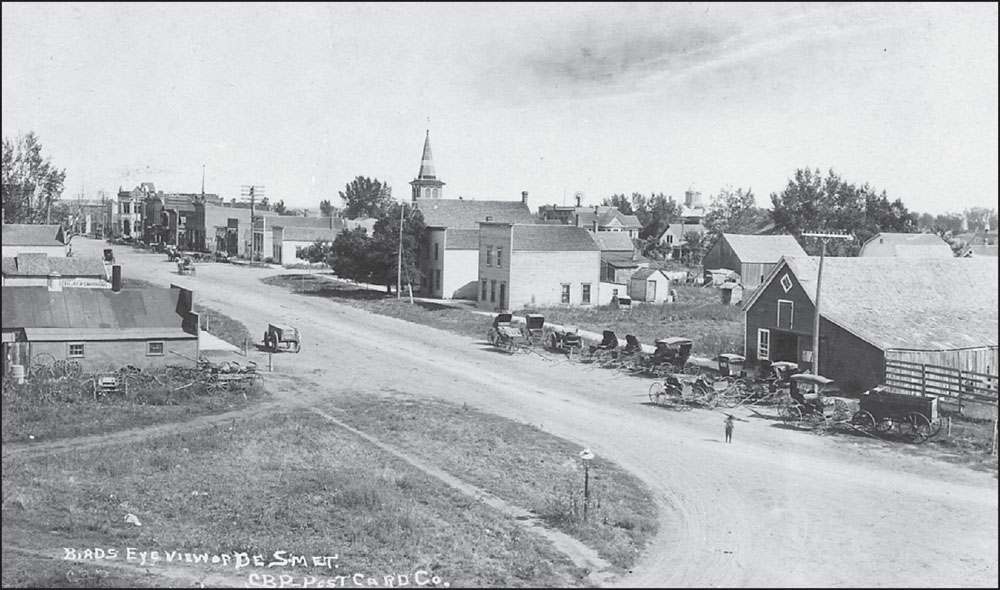
This timeless view of De Smet’s main street, looking north from US Highway 14, shows the livery barn (mentioned in Wilder’s book), a residence, the Evangelical church, telephone office, and the home of the De Smet News on the right; on the left is the blacksmithing shop, as the top of the sign reads. Gas streetlights and hitching posts are evident on the left, while the right side sports electrical poles.
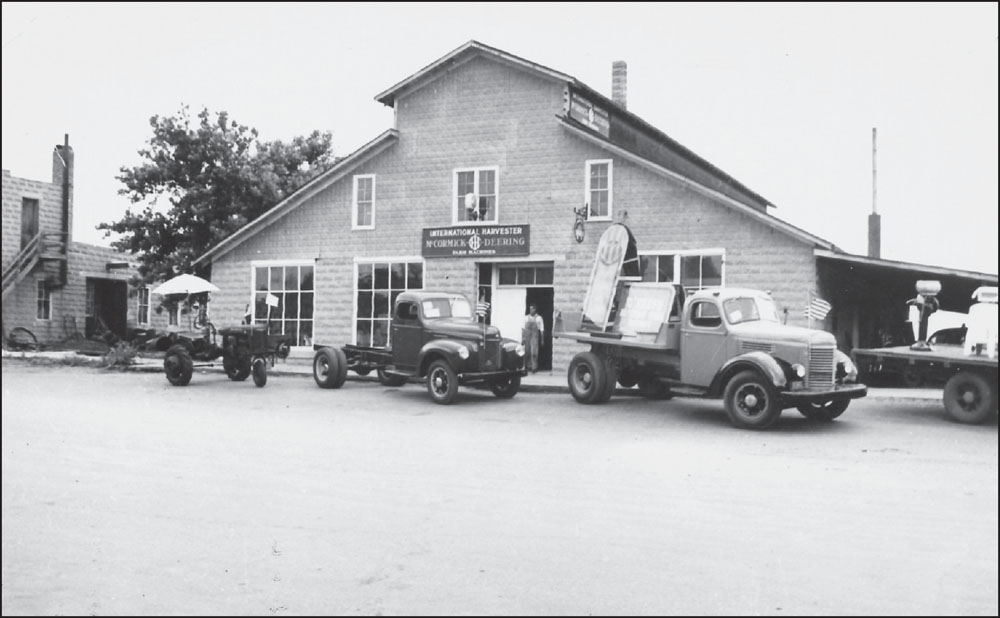
Rekindling the memory of the original O’Keefe Implement, this 1940s structure fronts a sign advertising “International Harvester McCormick-Deering” farm equipment. The way the trucks are lined up and with the cream separator and washing machine on the truck bed, it would be a good bet that folks are getting ready for the June 10 parade. Ernie Johnson’s blacksmith shop can be seen just to the left.
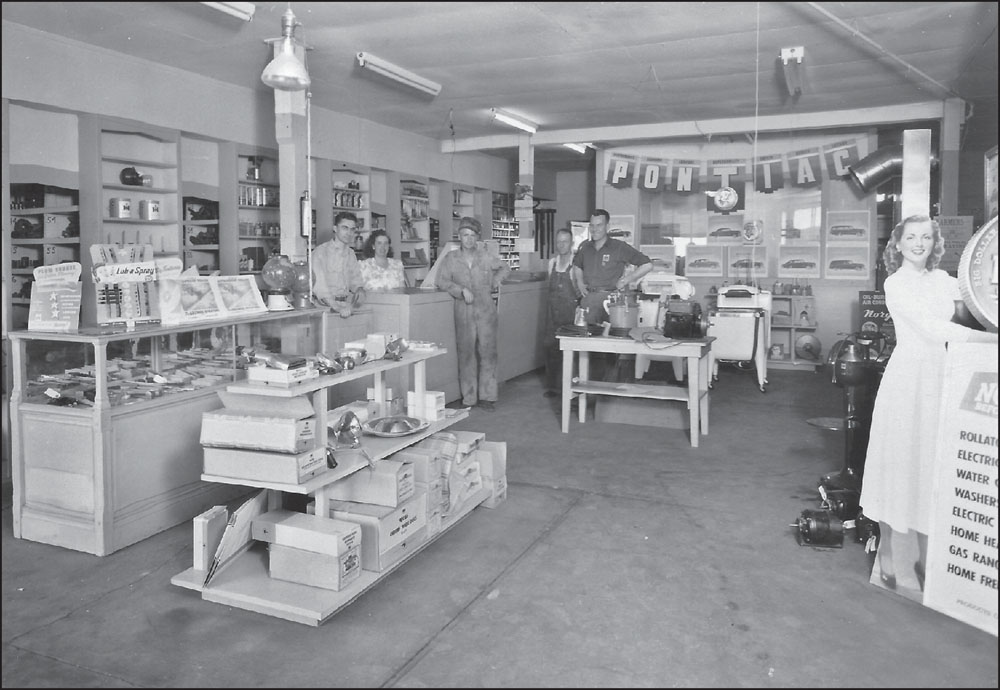
In this peek inside O’Keefe Implement, around the 1940s, the people include, from left to right, Thad O’Keefe, unidentified, Darcy Melstad, unidentified, and Gerald “Bud” Erickson.
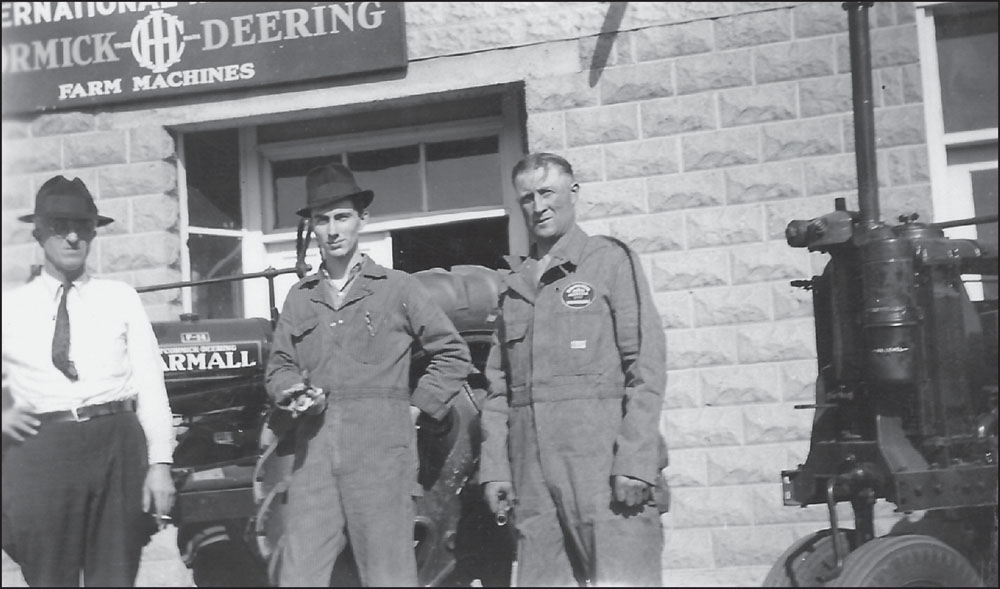
J.E. O’Keefe (left), Thad O’Keefe (center), and Len Musolf give a sense of sentimentality to this photograph from the early days of O’Keefe Implement. O’Keefe purchased the former business of Aderhold and Ellison and moved his International Harvester dealership from Yale to De Smet in 1938.
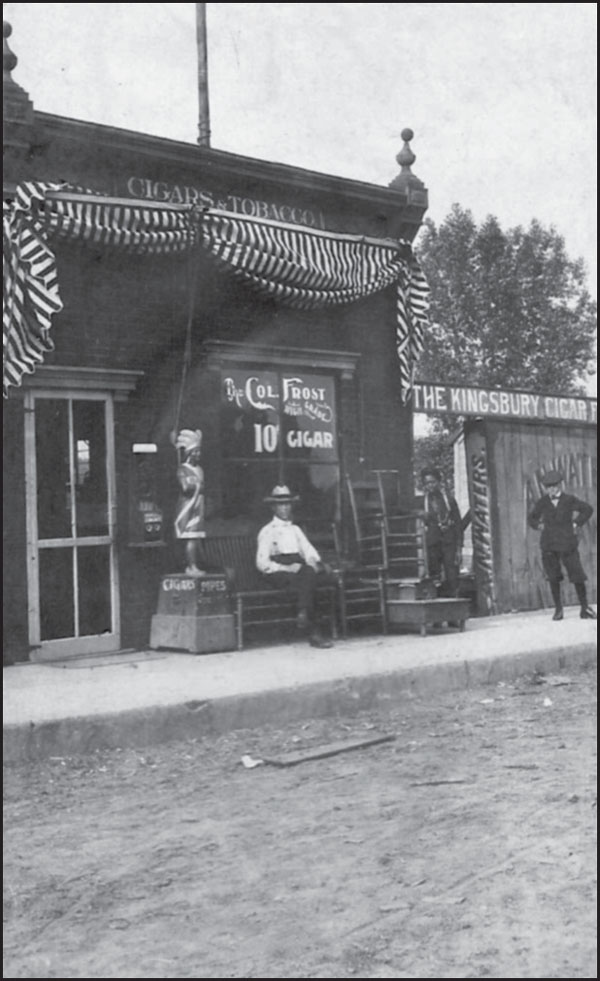
Kingsbury Cigar Factory was owned and operated by N.E. “Tack” Tackaberry. An unidentified gentleman sits in front of the store, perhaps waiting for a shoeshine. A.N. Waters owned of the property to the right. It is believed that Tack’s business sat on the south side of Second Street.
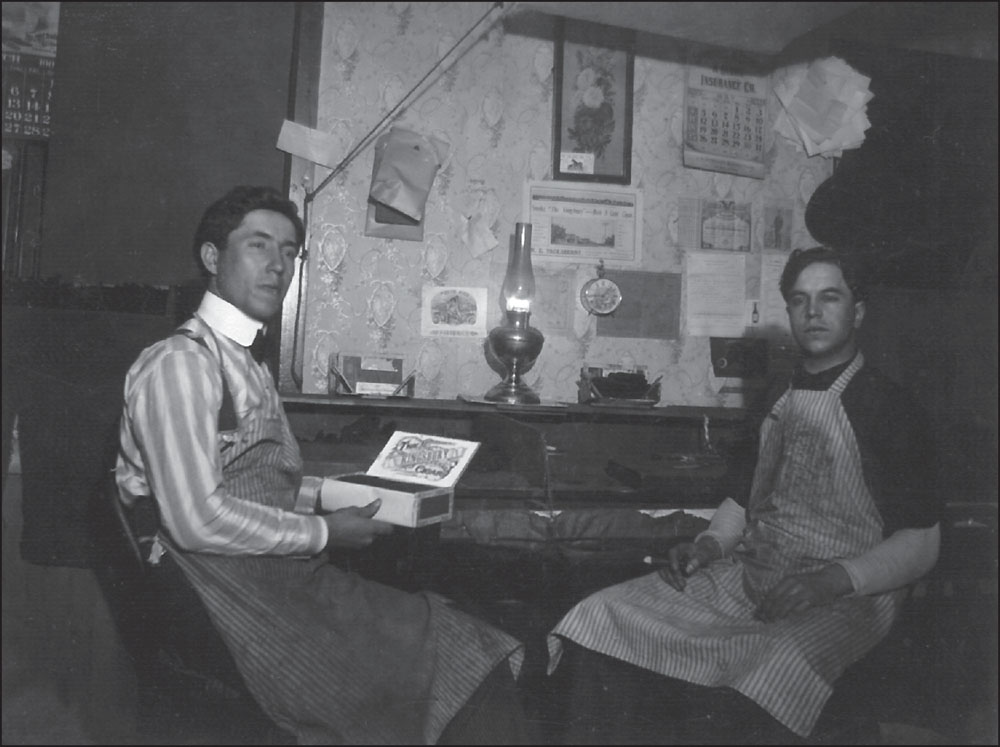
Tackaberry is seated left and is holding a box of Kingsbury Cigars. His help is unidentified. The year on the far left calendar appears to be 1902, and the month is March. The calendar at right shows the month of May. The lamp is lit and the time is 9:06. A poster on the wall above and to the right of lamp reads: “Smoke the Kingsbury Best 5 cent Cigar.”
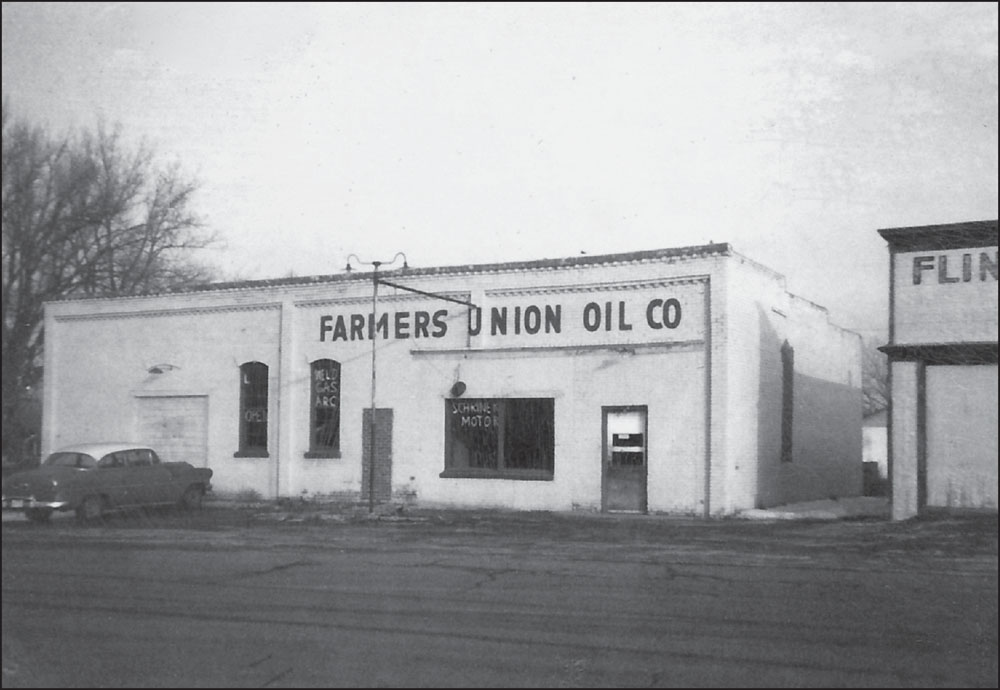
As America fell in love with the automobile, gas stations and repair shops sprang up like weeds. Farmers Union Oil Co., seen here in 1940, and Flindt’s Garage became an active part of De Smet. These buildings were located on South Dakota Highway 25, on the left-hand side when coming from the north. FU Oil moved to the corner of Second Street and South Dakota Highway 25 in 1964; the Flindt’s building was moved to the south of De Smet.
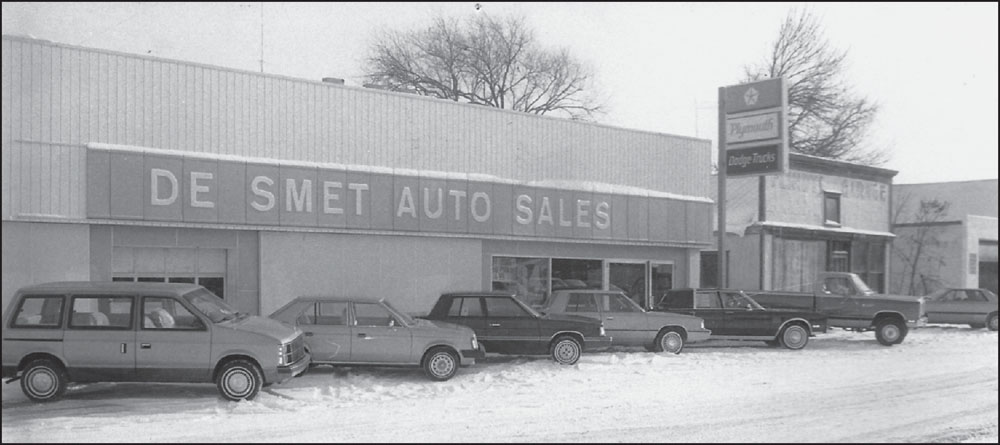
Glen Iverson knew the automobile gave people an opportunity to widen their horizons. He gave them the chance to own a car and the freedom to go anywhere they chose. Glen established his car dealership on the former site of the Farmers Union building on Highway 25. He operated his business from 1948 to 1993. The building was sold to Mid State Agronomy, and later to the City of De Smet for a fire station.
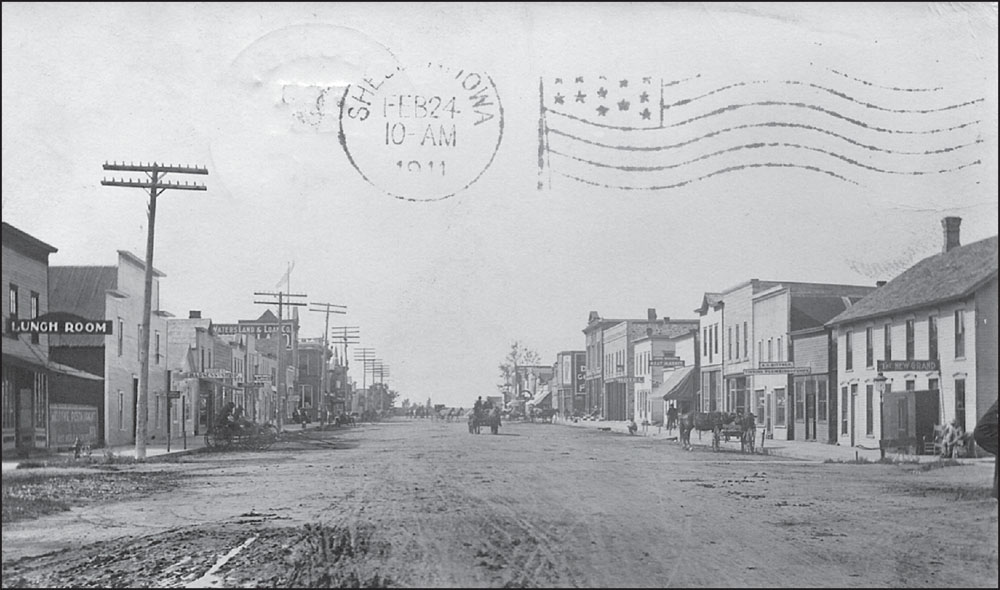
Rooms with a view—a view of Calumet Avenue, that is—could be rented at the New Grand Hotel, standing at the northwest corner of Calumet Avenue. Many know this hotel as the Meade, written about in Wilder’s book The Long Winter. It was also at one time known as the Exchange.
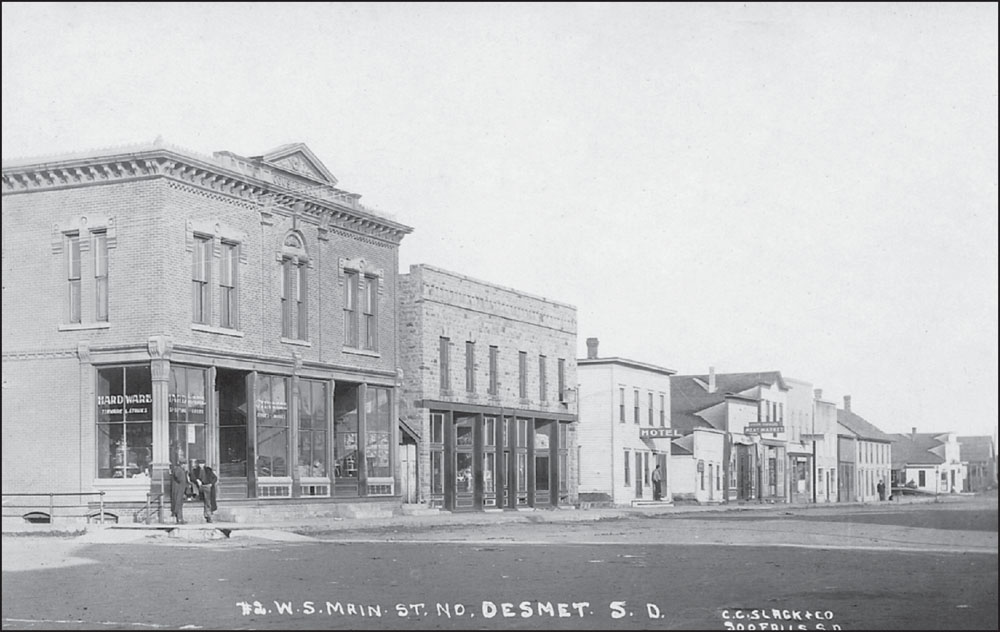
John Sturgeon brought this clapboard building (third structure from the left) in 1881. He enlarged the building, allowing for Kingsbury House to come into being. The Sturgeons operated the hotel for more than 50 years. It was razed around 1960 to make way for the De Smet Post Office. To its right is “Home of the De Smet DeLuxe Butter,” the Farmers Creamery, established in 1928. Rigid sanitary laws forced the creamery to close in 1971.
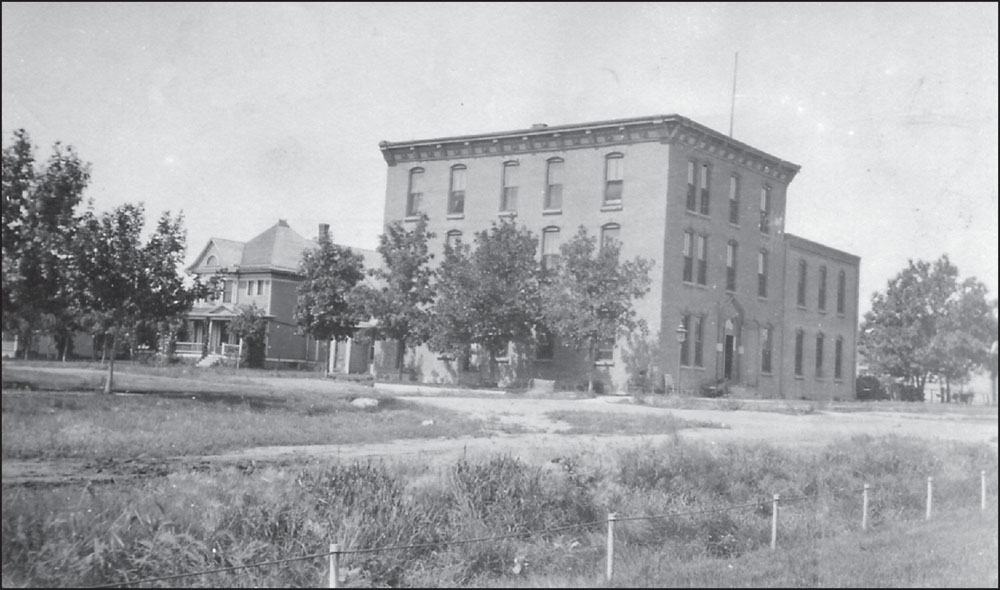
The heyday of hotels brought many guests to the Syndicate Hotel, located on the corner of Joliet Avenue and Second Street. The rear portion of the building was at one time the Garland House. Among early proprietors were Charles Ely, Pete Randklev, and the Moon family. The building was razed in 1991.
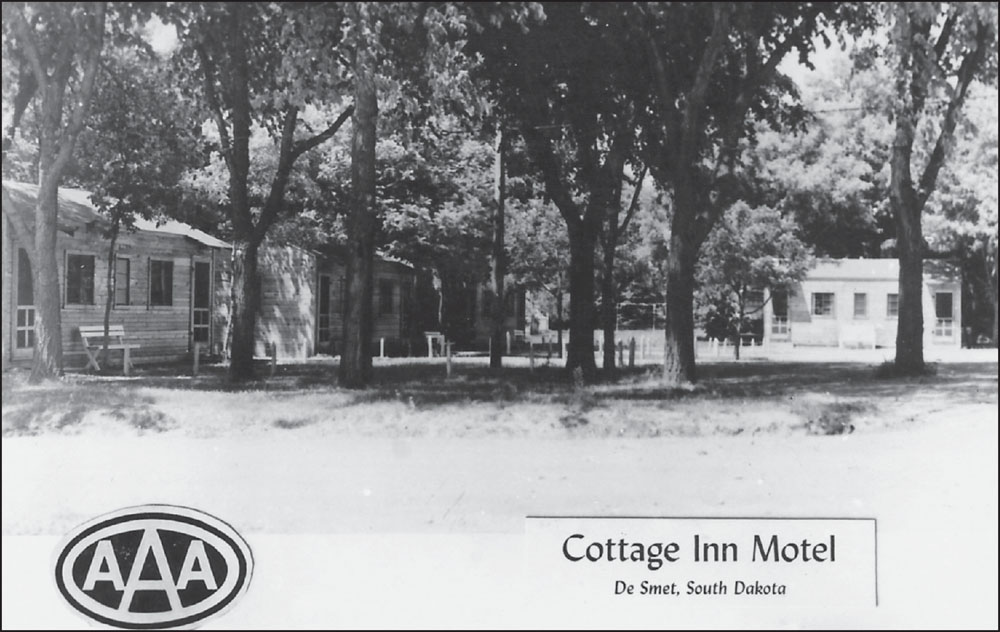
Living up to its billing, the Cottage Inn Motel has welcomed many guests, such as Laura Ingalls Wilder enthusiasts, vacationers, hunters, and fishermen. Established by A.J. Ryland, it has been family-owned and operated by the Myers family.
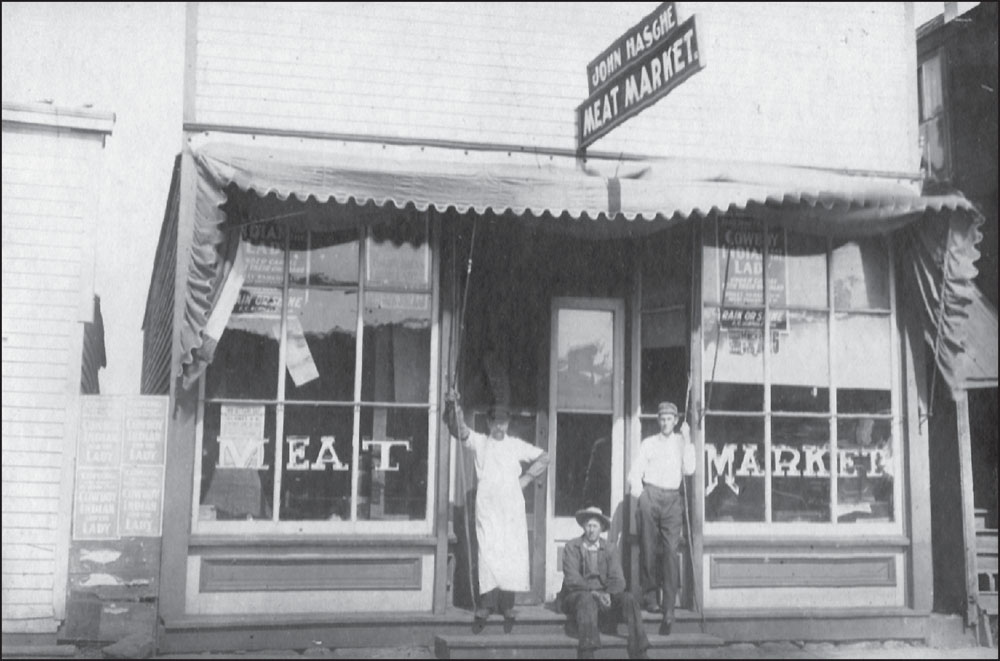
This image must have been taken in early summer, as the poster in bottom left window is advertising Old Settlers Day. John Hasche, right, is standing in front of his Meat Market in a pristine white apron. The gentleman on the left is unidentified.
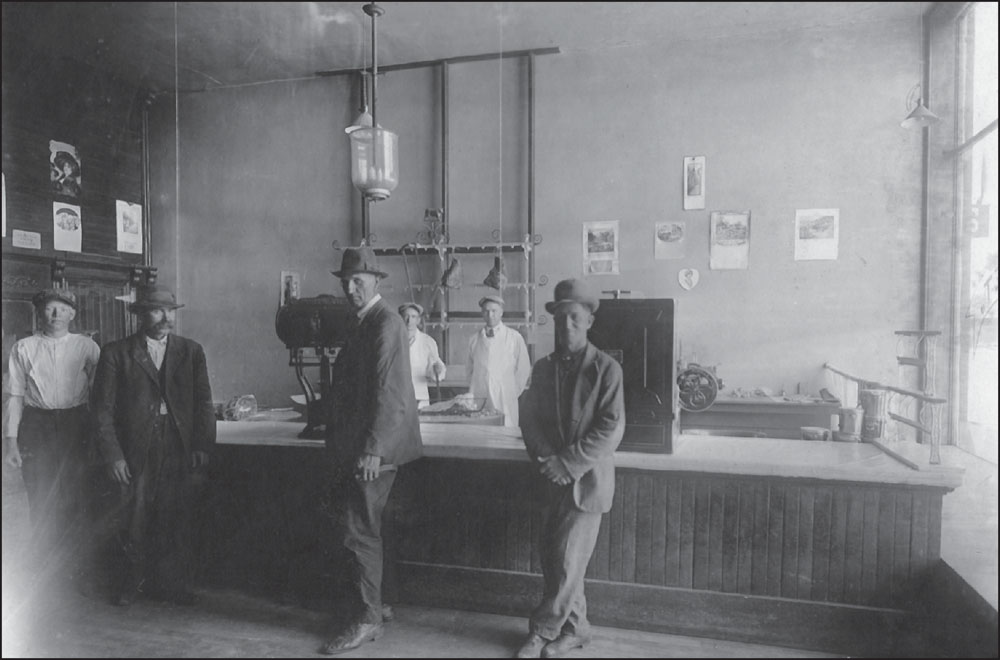
Hams hang aloft in Ed May’s butcher shop while Ed, left, behind butcher’s table, wields a knife. A gas ceiling light hangs over the counter, but there is also an electric light coming down from the ceiling immediately behind it.
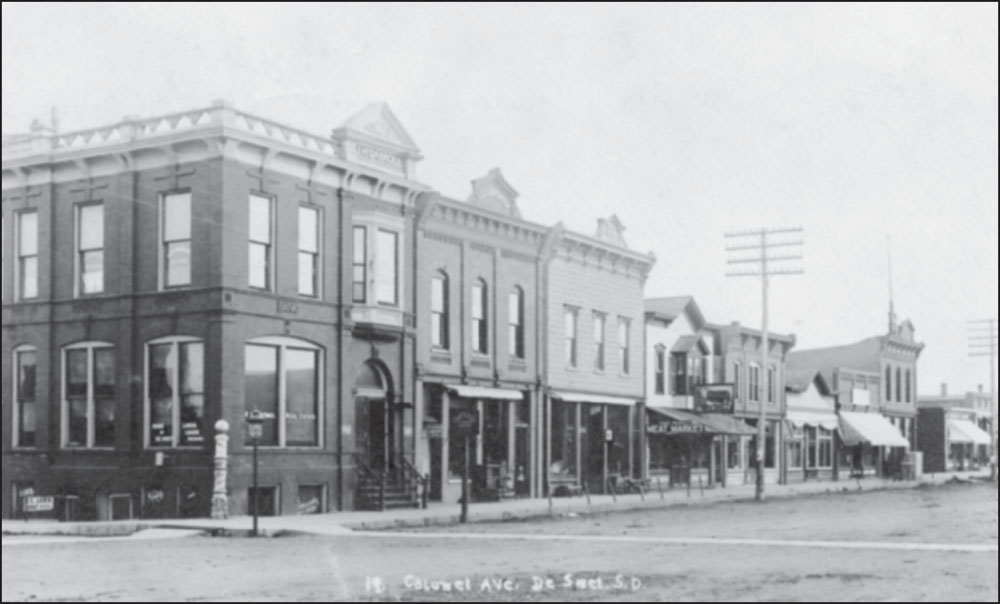
A picture paints a thousand words. This must have been the thought of the Rehfield Meat Market proprietor when he hung the picture of a Hereford bull to pose majestically over the awning of the market. The barber pole at the corner of the J.H. Carroll Building immediately catches the eye.
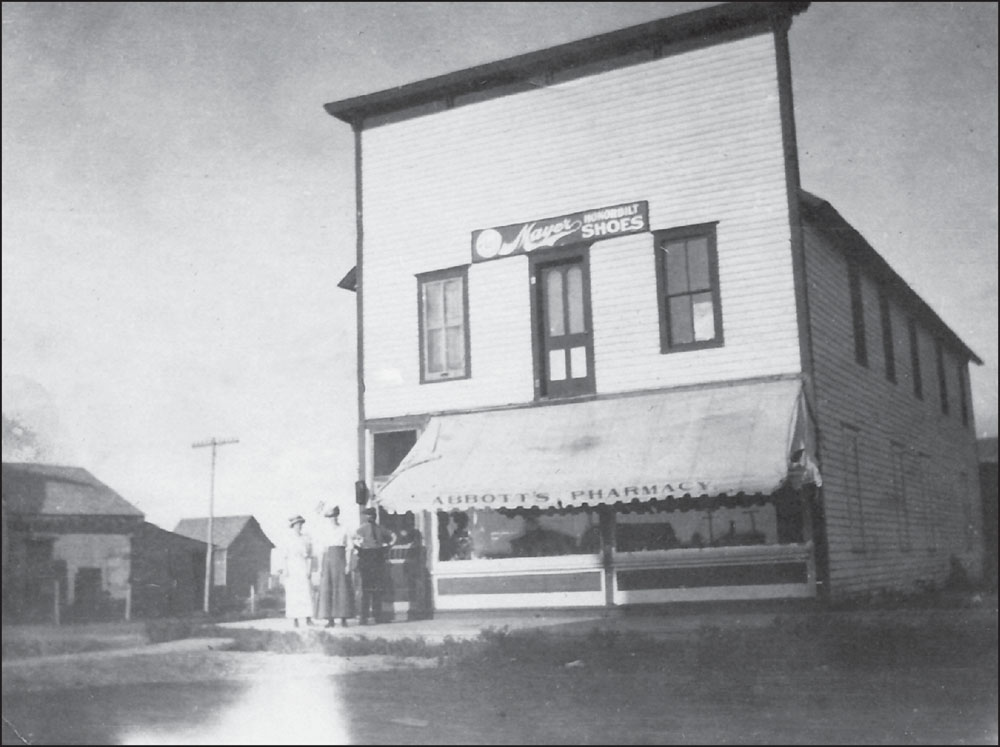
Little is known of Abbott’s Pharmacy, but the professional directory in the Kingsbury County Independent newspaper states that it was established and owned by C.H. Abbott, V.S.
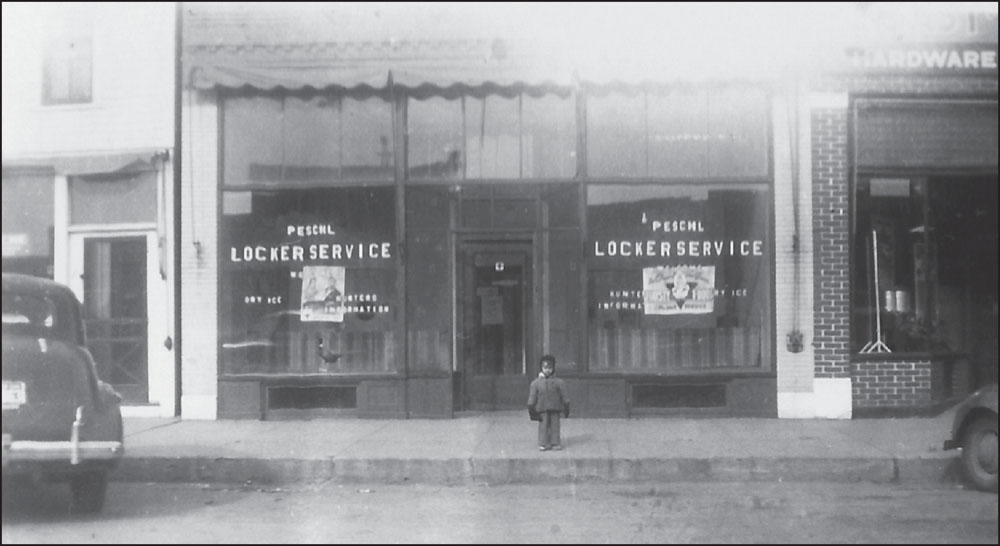
Originally constructed in 1888, the building in this photograph was home to Sasse Pharmacy and, later, Buchele Drug Store. Melvin Sorenson started the locker plant in 1945. Fred Peschl bought the locker service and operated it from 1946 until 1973. The window signs read “Hunters Information” and “Dry Ice,” indicating the fall season and the reason why young Terry Peschl is dressed in his warm clothing.
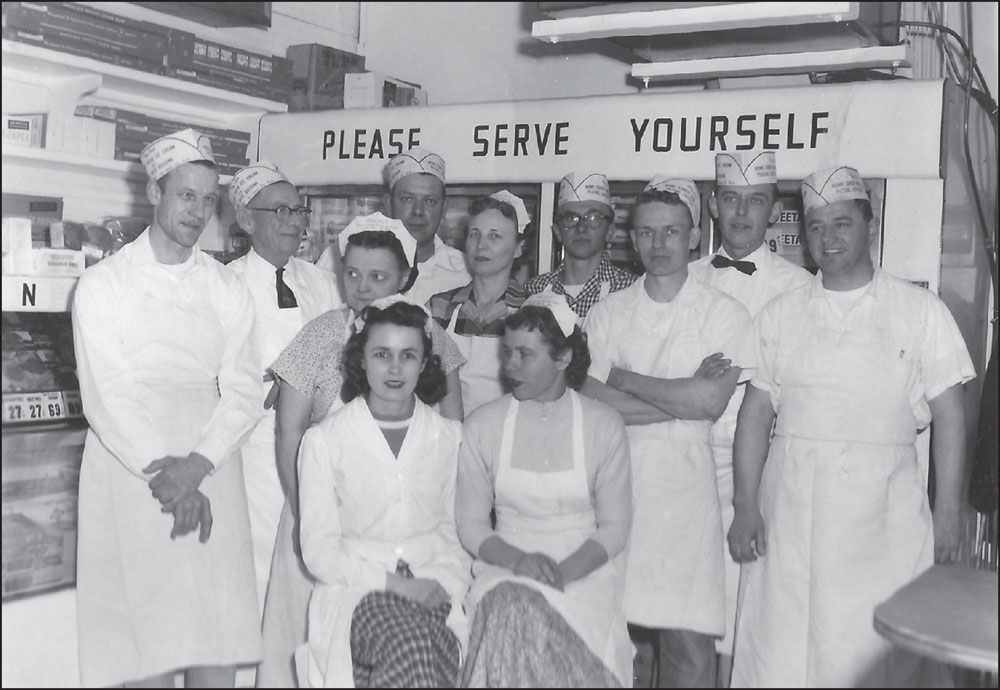
Though the sign reads “Please Serve Yourself,” Fred Peschl was always willing to serve his customers, as were his employees. In this image are, from left to right, (first row) Marcie Peschl and unidentified; (second row) Cecil Heim, Margaret Schultz, Joe Johnson, and Fred; (third row) Earl Kickland, Clyde Riley, Carl Thiele, Billy Kickland, and Bob Johnson.
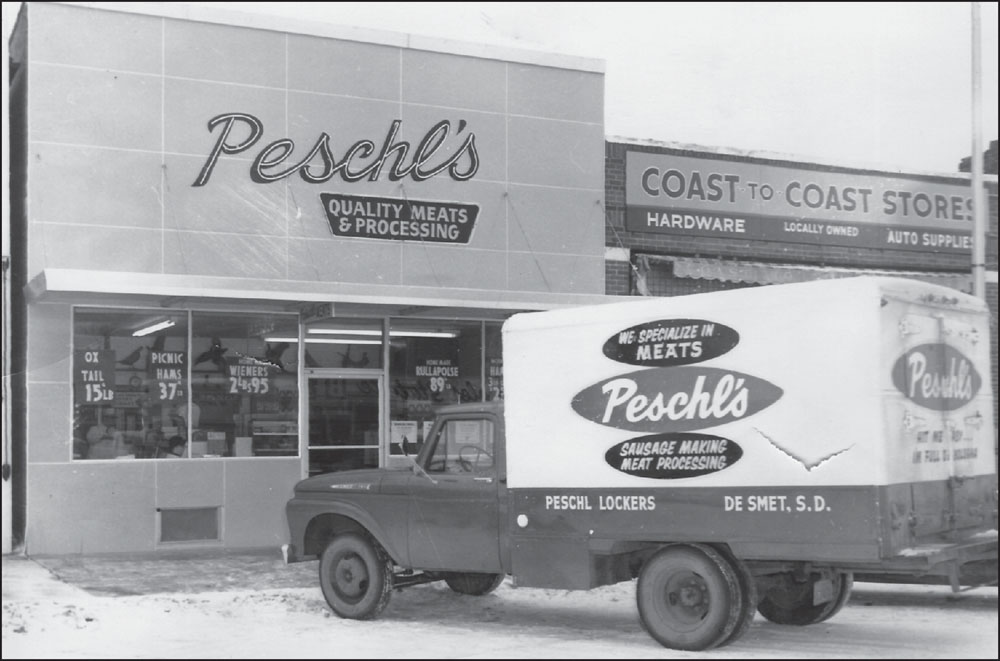
A face-lift was given to the Peschl building in the 1960s. A new truck with the admonition “Hit Me Easy . . . I’m Full of Bologna” on the back door is seen here; this phrase became Fred’s mantra.
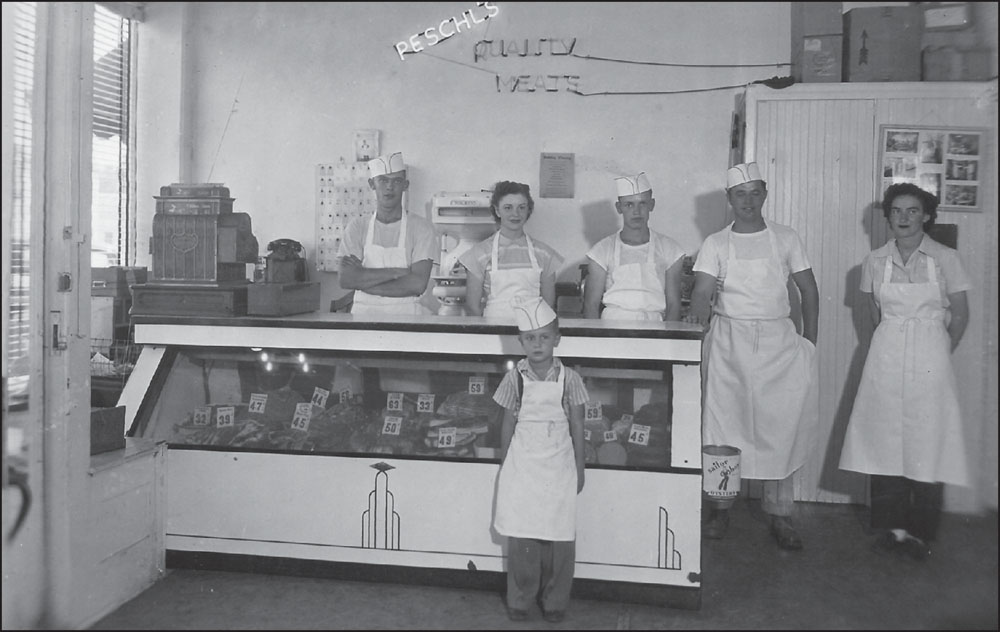
Inside the newly renovated Peschl building is freshly butchered meat on display. From left to right, Bob Johnson, Delores Aalbers, Joe Johnson, Fred Peschl and Shirley Garry are on hand to serve. Terry Peschl, standing in front of the meat counter, has his own apron and hat to wear. The keyboard behind the counter, to the left, holds keys to the lockers that patrons could rent to store their meats.
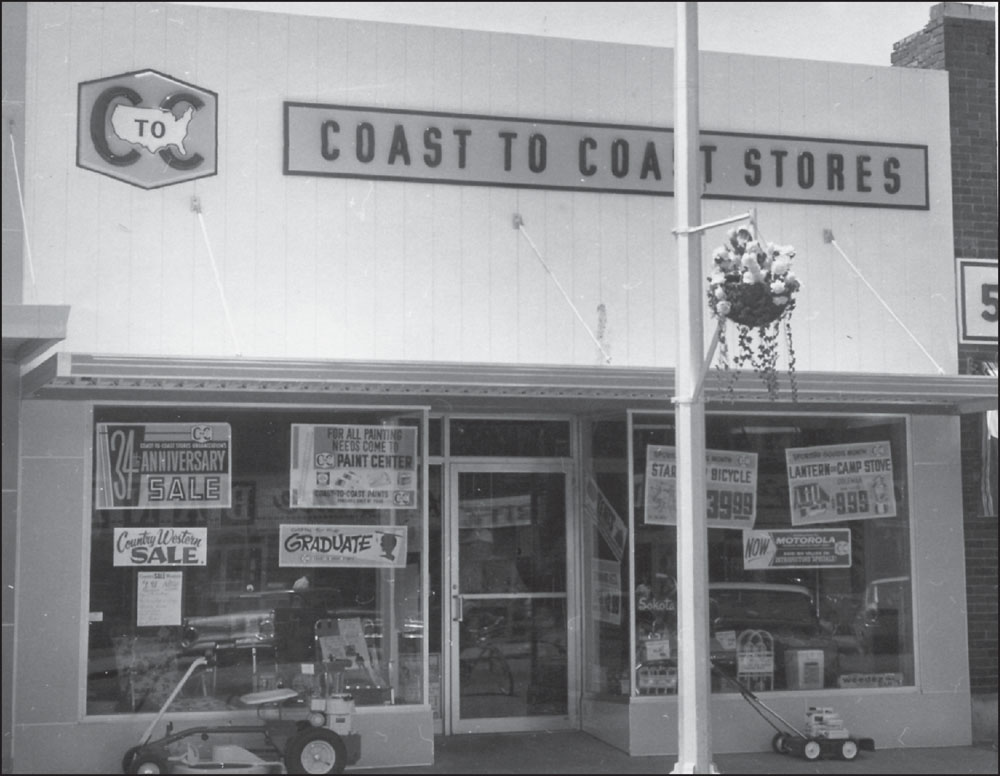
Fire took this business and building on March 2, 2002, when it was operated by Ron Beck, with Randy and LaVonne Bohn owning the building. Coast to Coast has been on the scene of De Smet’s main street since it was established in the late 1930s. Some owner/managers have been Ellis Day, Warren and Lorraine Widman, Clarence and Eunice Mutschler, and Randy and LaVonne Bohn.
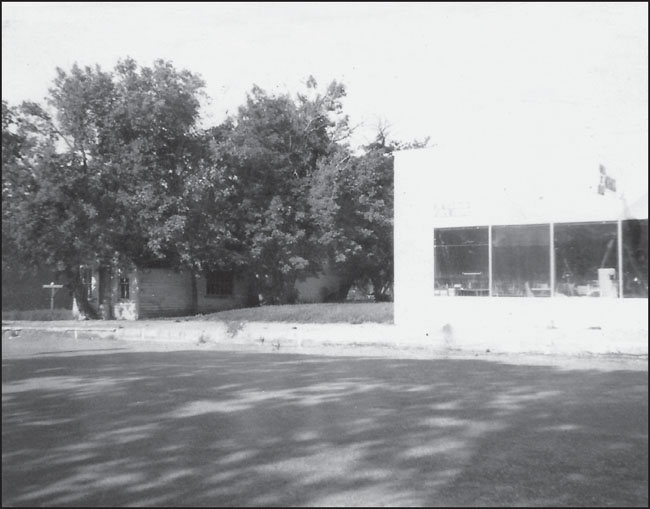
In this image, a former tailor’s shop is snuggled among the trees. When it was razed, there were tintypes from the work of photographer Cooledge, who had his photography studio in this building before it was the tailor’s shop. In later years, it was a private home. The display windows in Hyink’s Furniture Store on the corner of Calumet Avenue and Third Street can be seen here.
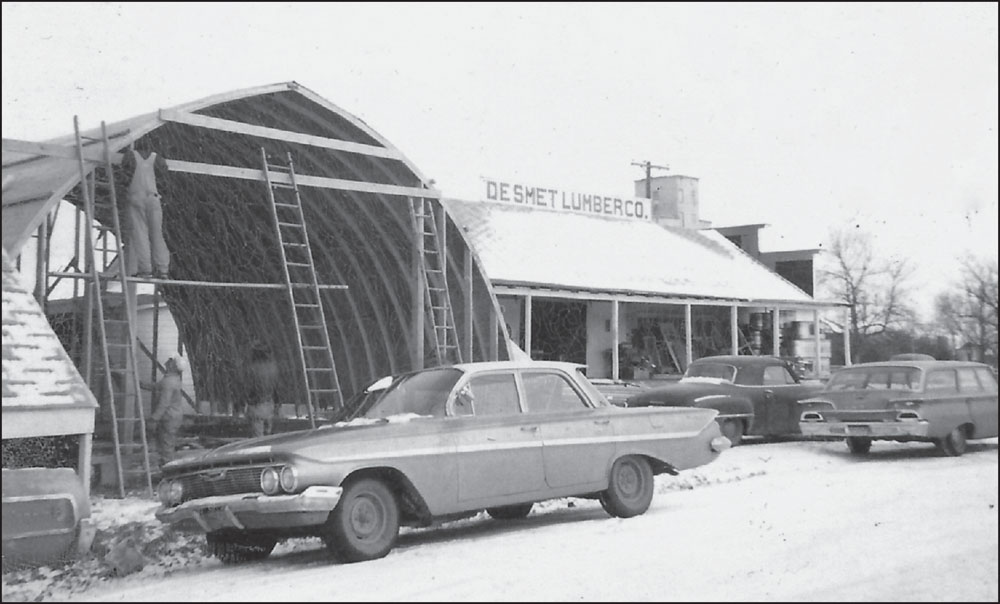
De Smet Lumber Company is building a Quonset hut to house more building materials. De Smet Lumber Company was established in 1932, when Bergstrom and Richardson bought out the Robinson Lumber Company. In 1961, the sole owner was Richardson; in 1966, the owners were Jim Kott and Elmer Johnson; in 1968, the sole owner was Johnson; but in August 1968, the business burned down. This is now the site of Dobson Chiropractic Clinic.
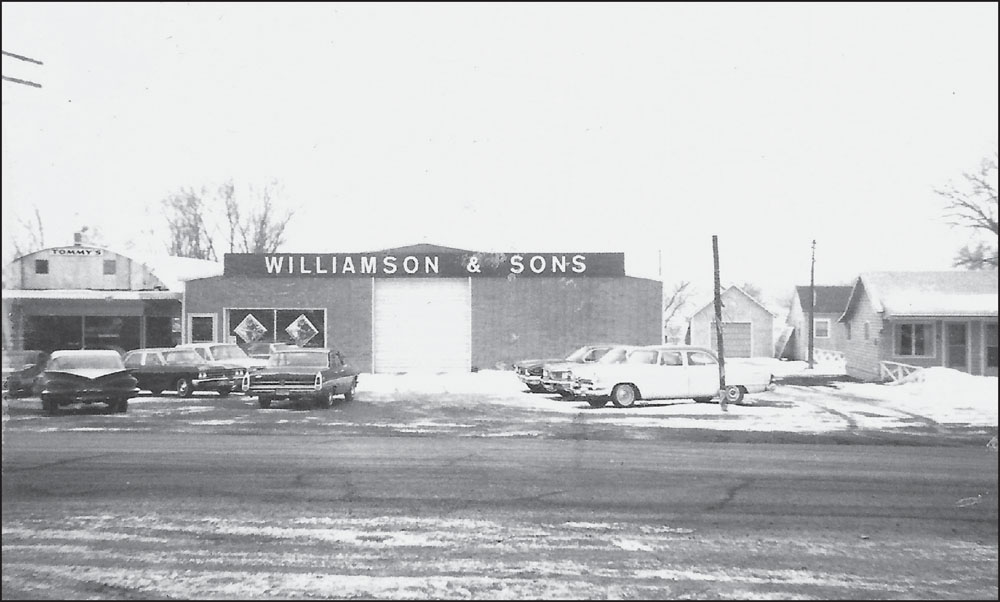
Williamson & Sons, a car dealership, was located on US Highway 14, just to the east of the Cottage Inn Motel. According to family, Tommy and Alice Williamson owned and operated the business for over 20 years. Tommy was the onetime owner of Tommy’s Standard Service, which was located on the north end of Calumet Avenue, but he gave it up to sell the items that needed gas to run.
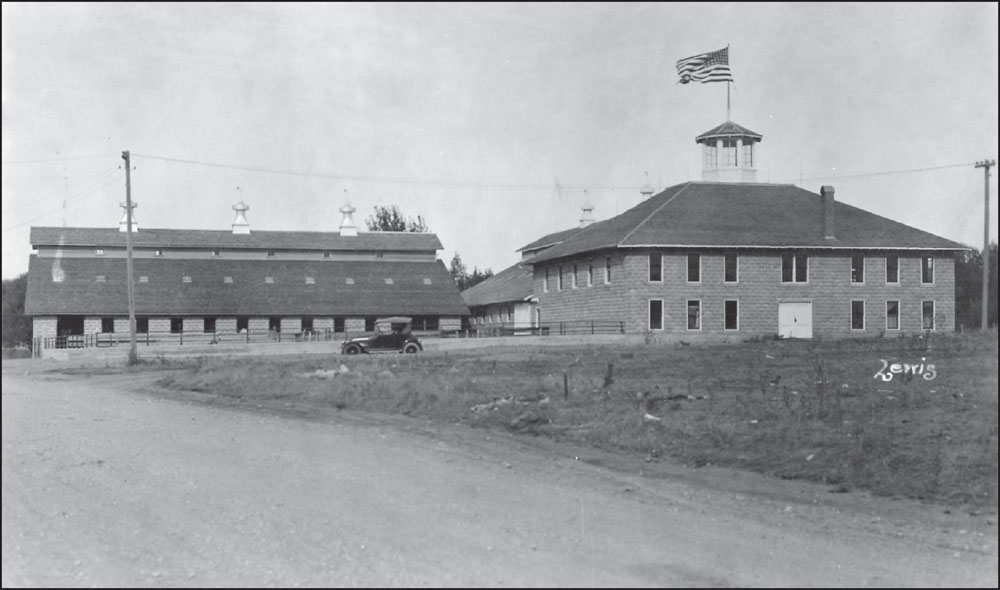
The pavilion was built in the early 1900s by the Kingsbury County Livestock Association. It was the pride of the community when purebred sales were at their height. It was purchased by Lars Carlson of Lake Preston in 1925, and H.O. and Harold Fritzel bought it in 1930. The barn to the left was torn down by owner F.L. Brewer in 1935. O.A. Erlandson’s John Deere Agency is seen here in 1936.
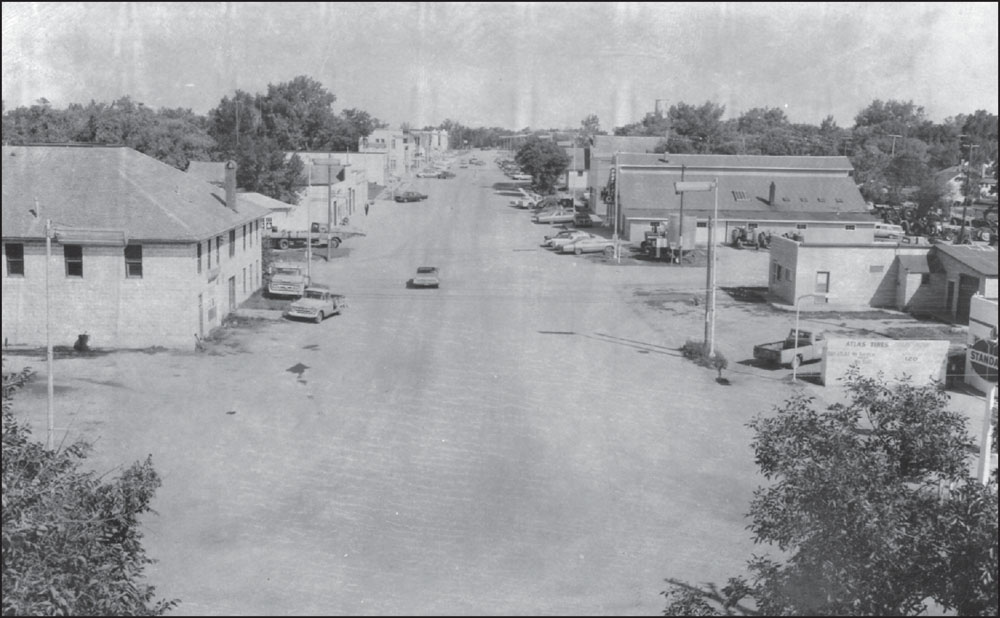
The pavilion complex sat on the corner of Calumet Avenue and US Highway 14, while the main building stood closer to Fourth Street. The last remnant of De Smet’s Sale Pavilion was razed in 1976 to make way for the OxBow Café and General Store, built, owned, and operated by Tex and Jill Myers. In the intervening years of 1936 to 1975, Jake Kruse had an implement shop and car dealership at the site; Larry Stalheim and Kenny Hummel bought out Kruse.
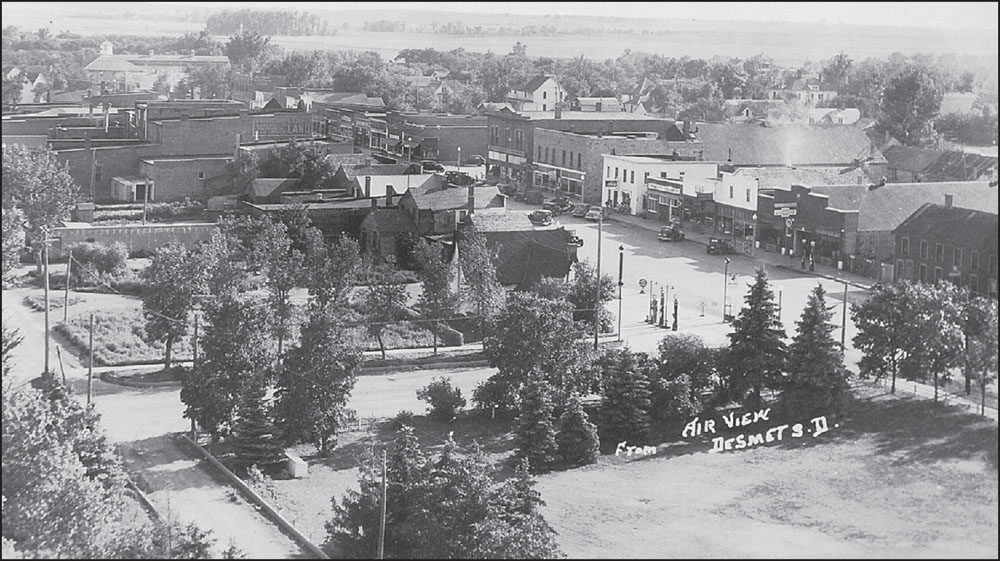
This scene, with a view looking from the north, gives a picture of how the little town came to be a growing city. Gas pumps and automobiles indicate that the horse-and-buggy era has been largely left behind.
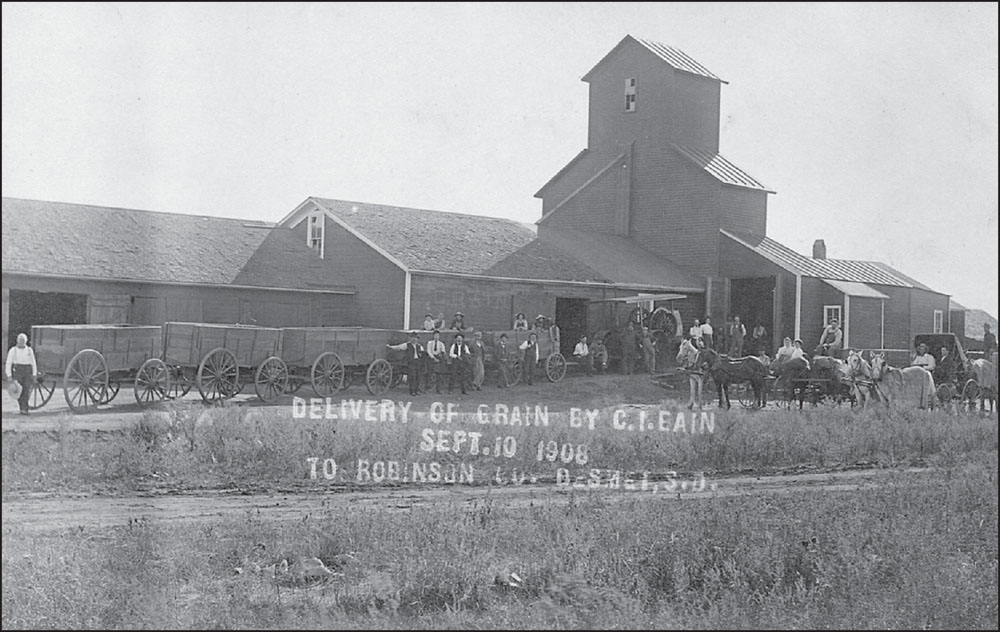
Apparently, whole families were involved in bringing grain to town, as there are women, men, and children in this 1908 postcard. Located at the corner of Calumet Avenue and First Street, Robinson Company was spread over quite a span of ground.
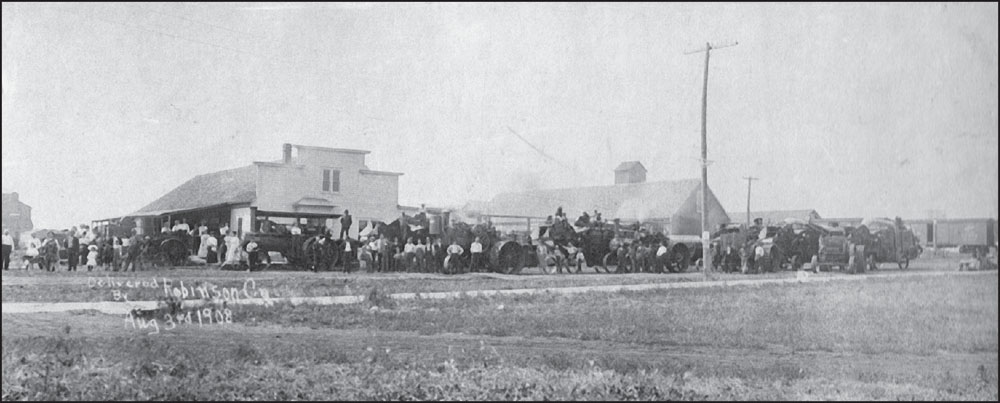
In 1908, the Robinson Lumberyard sold not only lumber but also a line of farm machinery. The whole family could check out the lineup. Thomas I. Robinson operated this business, with his brother William having a hardware store in De Smet and brother Elmer running businesses in Erwin.
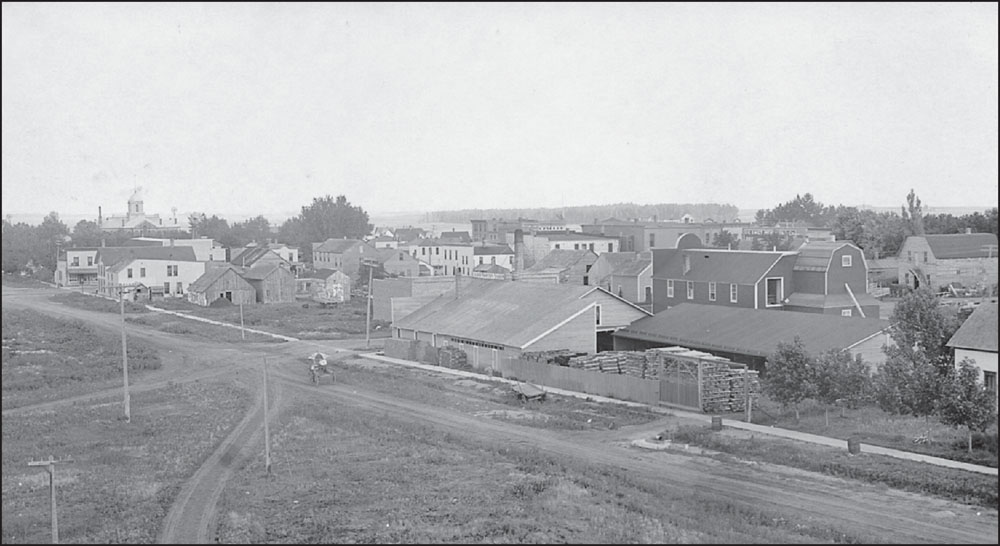
Another bird’s-eye view of De Smet was captured in this 1909 view looking east down First Street. The dome of the stately Kingsbury County Courthouse soars into the sky. The houses and buildings seem to be snuggled up and cozy.
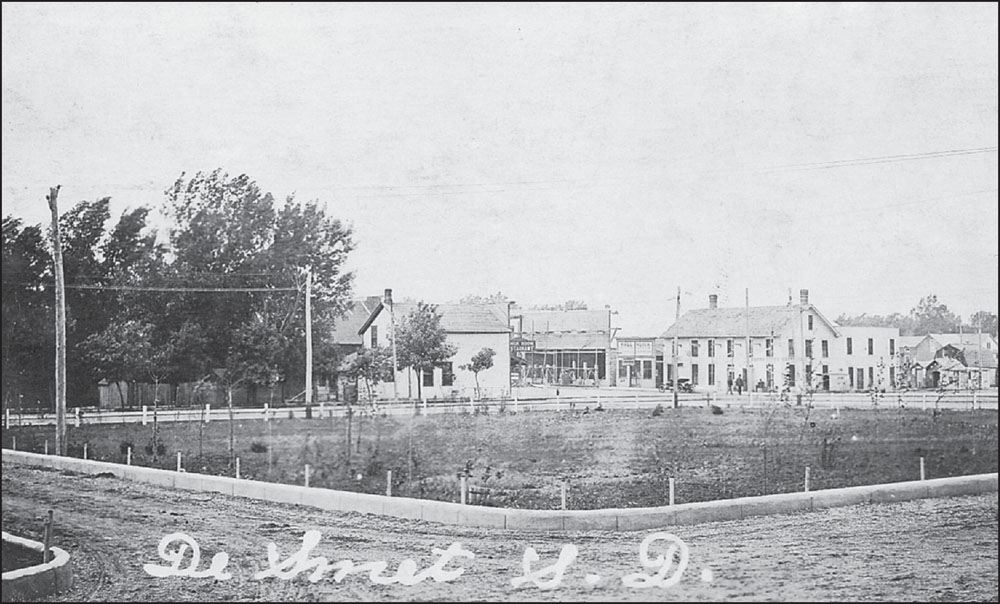
Passengers could disembark at the train depot and simply walk down Calumet Avenue to the Meade (later the Grand) Hotel to inquire about a room. The number of windows indicates an ample amount of rooms.
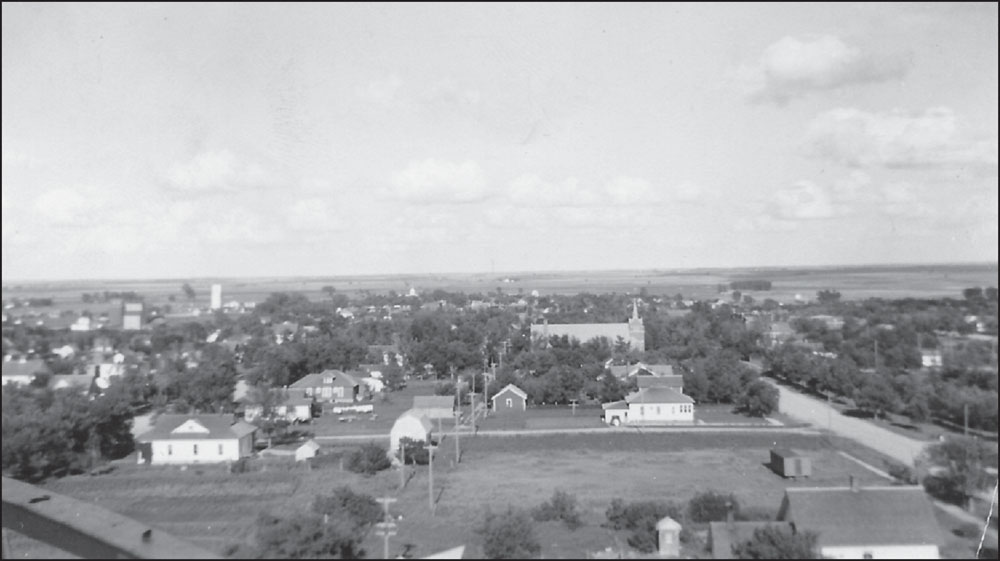
This picture turns the mind to the time of yesteryear, when houses were rather sparse in the west end of town. This picture was taken from the water tower, with a view looking east. The spire of the Catholic church is wending its way heavenward. The elevators stand tall, and a corner of Washington Park can be see on the right.
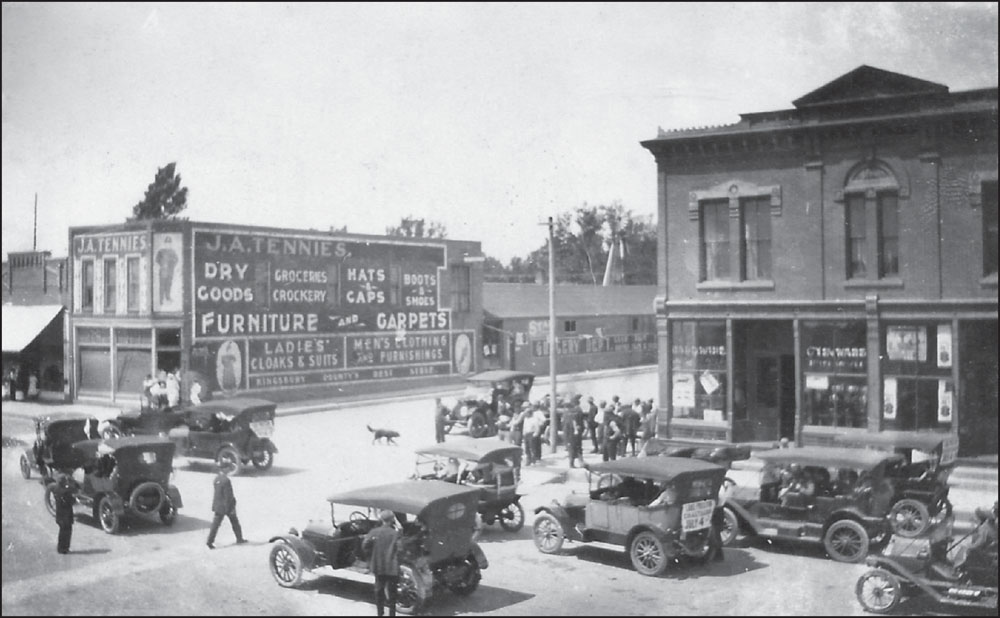
J.A. Tennies anchored the corner of Calumet Avenue and Second Street. The back building was the grocery department, according to the large lettering on its side. It appears as though the Tennies slogan could have been “if we don’t have it, you don’t need it.” The sign on the back of the vehicle reads “Lake Preston Chautauqua July 4th.”
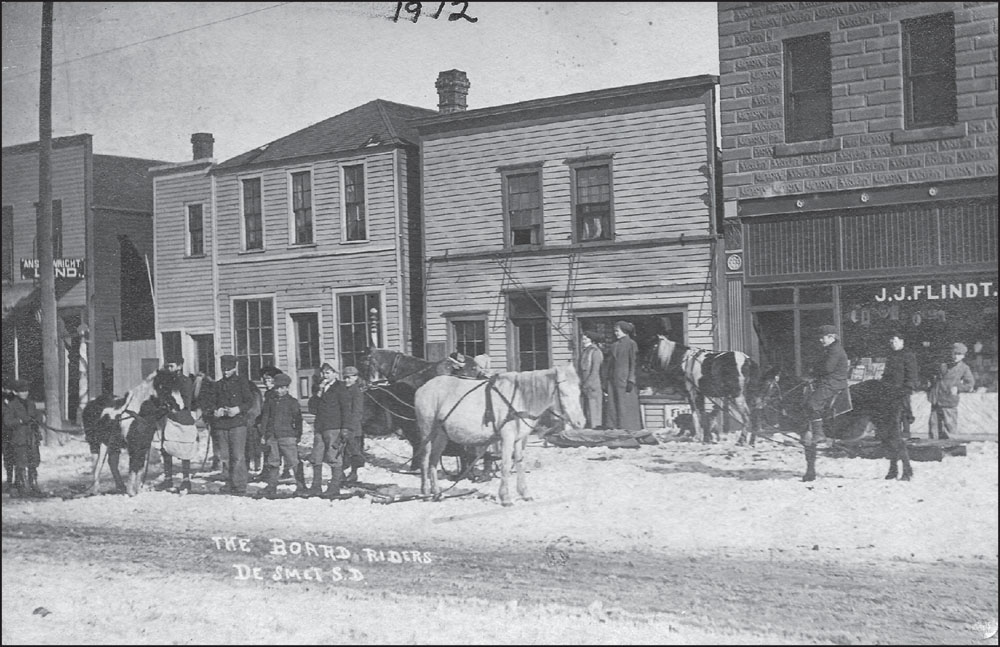
There could have been a feel of magic in winter 1912 as this group of boys with a sled, a board, and horses prepares to glide down the wide Calumet Avenue. The coat-clad ladies watch and listen, as they perhaps remember the yelling, laughing, and pure joy of this winter activity.














































































